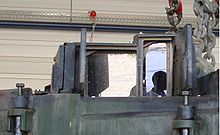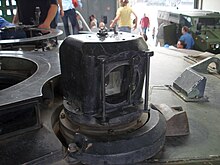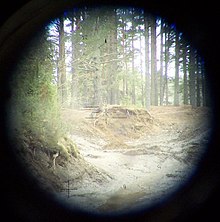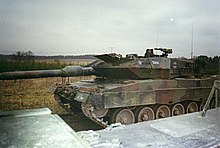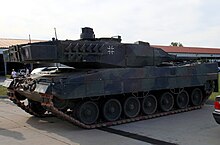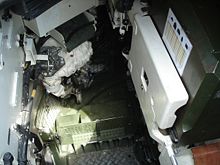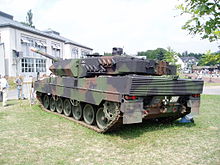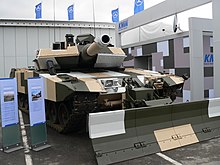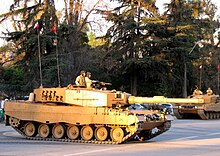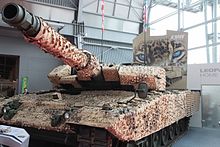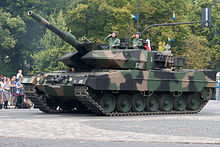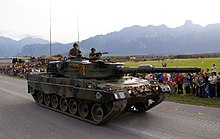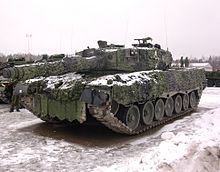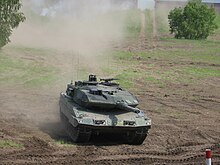Leopard 2
| Leopard 2 | |
|---|---|
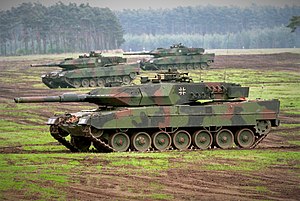
Leopard 2A5 of the Bundeswehr |
|
| General properties | |
| crew | 4 (commander, gunner, loader, driver) |
| length | Tower 12 o'clock 9.67 m (A4, A5) 10.97 m (from A6) |
| width | 3.70 m (A4) 3.76 m (from A5) |
| height | 3.03 m (upper edge PERI) |
| Dimensions | 62 t (A6) |
| Armament | |
| Main armament |
120 mm smoothbore gun, 42 rounds |
| Secondary armament | 2 × 7.62 mm MG 3 4750 rounds |
| Protection systems | |
| Armor | 3rd generation composite armor, additional armor in bulkhead construction |
| Mine protection strength | A6M: STANAG 4569 Level IV, 10 kg anti-tank mine and EFP mine |
| agility | |
| drive |
12-cylinder - diesel engine MTU MB 873 1,500 hp (1,103 kW) |
| suspension | Torsion bar suspension |
| Top speed | 68-72 km / h |
| Power / weight | approx. 17.8 kW / t (24.2 PS / t) (depending on the variant) |
| Range | approx. 500 km terrain: approx. 161 km |
The Leopard 2 is a battle tank made in Germany . It has been in series production since 1979 and is the successor to the Leopard 1 . In the long production period, various optional retrofitting options and specifications for foreign customers arose. That is why there are a large number of variants of the Leopard 2. It is manufactured in whole or in part under license abroad . For the manufacturer Krauss-Maffei Wegmann - 1979 Krauss-Maffei - it is a commercial success with around 3,600 units built. By 2008, the Bundeswehr had reduced its number of active Leopard 2s from 2,125 in 1990 to 350. As part of the realignment of the Bundeswehr , this number was to be reduced further to 225, but was increased again to 328 in April 2015 due to the changed security situation. The A6 version with a longer cannon has been in service since 2001. The Leopard 2 tank was originally intended as the backbone of armored forces and to defend against enemy tank units. It was used for the first time at KFOR in the aftermath of the Kosovo war . The NATO countries Denmark and Canada deployed the Leopard 2 in the ISAF mission in Afghanistan and Turkey from 2016 to 2019 in northern Syria.
history


The Leopard 2 main battle tank has its roots in a bilateral armaments project between the USA and the Federal Republic of Germany . Both states strove to replace the M48 Patton II models in Germany and the M60 in the USA. Therefore, in August 1963, it was decided to develop a uniform main battle tank for the respective armed forces as part of a government agreement. The project with the name Kampfpanzer 70 ( KPz 70 or English MBT 70 ) failed due to the very high demands placed on this vehicle: fire fighting from moving towards a moving target, weapon tracking, automatic loader, 20 mm secondary weapon system and the The arrangement of the driver's cab in the tower were just some of the requirements that were far ahead of their time. After seven prototypes and 830 million DM development costs, the program was discontinued in 1969; However, both partners let the development results of the KPz 70 flow into their national tank projects. The M1 Abrams was built on the US side , while the Leopard 2 was built in Germany.
The actual beginning of the development of the Leopard 2 can be traced back to the year 1970 - after the discontinuation of the MBT 70 project, the decision was made to build a new, own battle tank; an increase in the combat value of the Leopard 1 was rejected (project designation Gilded Leopard ). The then Defense Minister Helmut Schmidt stipulated that the new building should be based on the experimental development Keiler (Leopard 2K) by Krauss-Maffei, Porsche and Wegmann, which began in 1968, as well as the assemblies of the failed Kpz-70 project. The Eber (Leopard 2FK) study with the 152 mm M81 “ Shillelagh ” combination weapon, initiated by the Ministerial Director Eberhardt, Armaments Department at the Federal Ministry of Defense , was not pursued.
The first prototypes of the "Leopard 2K" (cannon) were built between 1972 and 1974 for testing purposes. The 16 chassis were given the designation PT (PT 1 to 17, the 12 was not assigned) and used the advanced engine of the battle tank 70. The 17 towers of the first generation were designated T1 to T17 . The similarity of the turret shape to the Leopard 1A3 and 1A4 was intentional, as the EMES 12 rangefinder had to be retrofittable in the Leopard 1. The armouring of the hull and turret was made of mild steel, PT / T 6 to 10 and PT / T 13 to 17 were made of armored steel. Smooth-barreled cannons in caliber 105 mm and 120 mm served as the main armament . The turret 11 received the apex mounted 20-mm automatic cannon as secondary armament. In addition to the torsion bar suspension, the hydropneumatic spring system of the KPz 70 was also being tested .
In 1973 the first troop attempt at combat force school 2 in Munster followed with two prototypes; further tests with four additional prototypes followed in the summer of 1974. The climate tests in 1975 at the military training area Shilo / Canada and in Yuma (Arizona) served to determine the resilience. Another five prototypes were used at the Trier , Meppen and Greding test sites for system and component analysis. The prototype PT 7 was sold to the USA.
The second generation of the prototypes, which should at least outwardly come close to the later production version, were the Leopard 2 AV. Based on the findings from the Yom Kippur War in 1973, the armor protection was significantly improved, which led to a redesign of the hull and turret, but also raised the combat weight of the tank well above the targeted MLC 50 and therefore established the MLC 60 as the new upper limit. The bilateral study of a double-barreled casemate tank , in which the MLC-50 limit was complied with, was an alternative to the Leopard-2 development for a short time, but was not successful.
Due to the new protection concept and the elimination of retrofitting the Leopard 1, the first generation tower 14 was converted to the T14 mod. Due to reservations about laser rangefinders, Leitz built the EMES 13, a passive rangefinder that was based on the correlation principle and had a basic width of 350 mm. This allowed Wegmann to construct the shrew tower . Ultimately, the US demand for a better protection concept and the available composite armor led to the angular shape of the series tower. An auxiliary power unit from the first prototypes designed for the electrical supply of the vehicle when the engine was at a standstill and for preheating was omitted in favor of a larger tank volume. It was only 30 years later that the additional power supply was implemented based on the experience gained during operations in crisis areas. In addition, the fire control system (FLA) has been simplified; the optics were primarily stabilized, the bottom of the tank made mine-proof and the electronics, including hydraulics and ammunition, embedded in the turret rear. The previously used night vision devices were replaced by a thermal imaging device, which, however, was not yet available. The main armament was on-board cannons in caliber 105 mm and 120 mm. The armor was made of normal steel, the firing vehicle was made of armored steel.
Another important step was marked in 1976 by comparative testing of the Leopard 2 AV (PT19 / T19) with a 105 mm drawbar cannon and the XM1 (prototype of today's M1 battle tank) in the Aberdeen Proving Grounds , Maryland / USA. Here, the advantages and disadvantages of the two weapon systems were determined for the first time, although a commitment by the two states to a common battle tank was rejected from the outset by both sides. Of the 117 criteria established, of which 77 were evaluated, the Leopard 2 fulfilled AV 61 and the XM1 48. In 17 evaluation groups, however, only six were fulfilled by the Leopard 2 and 16 by the XM1. Evaluated according to the German system, in which each criterion was assessed and evaluated individually, the Leopard 2 was clearly superior to the XM1. The XM1 lacked the NBC protection system, an independent periscope for the commander and the ability to go underwater. However, according to the instructions of the then Defense Minister Georg Leber , any kind of protest had to be avoided. The signed letter of intent (MoU - Memorandum of Understanding ), in which the test conditions had been accepted, prohibited any contradiction. Instead, as many assemblies of the two tanks as possible should be identical. However, due to the advanced development phase of the German system and a different view of the performance of the respective in-house production, this only came to the fore. Significant changes on the way to the production vehicle were the installation of the 120 mm smoothbore cannon and the decision to install the license-produced laser rangefinder from the US company Hughes , which was cheaper and ready for series production compared to the EMES 13. Instead of the WBG-X thermal imaging device from Zeiss, the WBG basic device (US Common Modules) from Texas Instruments was selected. After the tests were completed, the 120 mm weapon system that had been brought along was installed in the AV on site to demonstrate its feasibility.
The Americans initially rejected the German smoothbore cannon and stuck with the 105 mm M68 cannon (variant of the British Royal Ordnance L7 ), but took over the German chains and ammunition holders. In 1985, the 120 mm smoothbore cannon was built into the M1 under license from the US - then designated as the M1A1. Plans to install the American gas turbine in the Leopard were examined by the company Maschinenbau Kiel (MaK) on a prototype in 1977 and 1978, but discarded due to the advanced stage of development because the tank would have had to be changed again.
In 1977 the then Krauss-Maffei company - today's Krauss-Maffei Wegmann - was designated as the general contractor for the delivery of 1,800 Leopard 2 battle tanks, 810 tanks (45%) were owned by the MaK company (since 2000 Rheinmetall Landsysteme ). The production should take place in five construction lots. At the end of the project, however, there were eight lots with an additional 325 Leopard 2. In the variants A0 to A4, 2125 copies were produced for the German armed forces. A total of 1500 companies took part in the production.
In September 1977, the Leopard 2 AV was presented to the public for the first time at an army show in Cologne-Wahn. After three Vorserienfahrgestellen to troops experimental purposes, the first was in mass-produced battle tank type Leopard 2 on October 25, 1979 in Munich the panzerlehrbrigade 9 passed in Munster.
According to the procurement instructions, the development costs for the Leopard 2 program amounted to 359.4 million German marks , but without taking into account the further development of the engine from the Kampfpanzer 70 program and the development of the 120 mm smoothbore gun including ammunition. The real costs rose to DM 600 million, which includes all items from experimental development to series production (1967 to 1984). The system price for a Leopard 2 in the 21st century is quoted from three to seven million euros, which fluctuate due to inflation and exchange rates and also depend on the number of items ordered. In addition to the vehicle, the price includes technical support and spare parts over a certain period of time. The Leopard 2 is to remain in service with the German Armed Forces until 2030 and will then be replaced by a successor, the development of which is to have started in 2015 as a Franco-German project under the name Main Ground Combat System (MGCS).
Function description
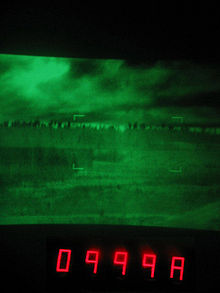
The Leopard 2 is a post-war third generation main battle tank with a crew of four. In a conventional design with a rear engine, it was designed for the concept of combined arms combat for anti-tank combat in conjunction with the Marder armored personnel carrier . It is the main weapon system of the armored forces of the Bundeswehr as well as foreign user states.
It consists of a tank with a self-supporting turret on top with a 120 mm smooth -barreled cannon as the main armament, a smoke-throwing system and two machine guns of different types, depending on the user state, as secondary armament. The fire control system in the tower enables the gunner to conduct fire fighting with stationary or moving targets, both while standing and while driving.
The tank was subjected to combat value increases several times. In the A5 version, additional armor was attached to the tower front ; a separate thermal imaging device for the commander made him independent of the gunner. With the residual light amplifier for the driver, the tank is fully capable of night-time and limited all-weather combat. With the A6 version, the firepower has been increased. Compared to the standard L / 44 cannon, the L / 55 is 1.30 meters longer and enables the powder energy to be converted better into projectile speed. This in turn increases the range, shot precision and penetration performance of APFSDS projectiles.
To protect the four-man crew, like all tanks of the Cold War, it has an NBC protection and ventilation system with an output of 300 m³ / h, which is intended to ensure endurance in areas contaminated with NBC weapons . The maximum duration of use is specified as 48 hours.
Like other main battle tanks, the Leopard 2 can cross bodies of water without the aid of pioneering technology . To 1.20 meter of water it is no superstructure or preparations for fording . With the foldable 50 centimeter deep wading shaft that is carried along, his deep wading ability increases to 2.25 meters; Thanks to a three-part rigid underwater drive shaft that is not carried, it can be driven underwater up to a water depth of 4 meters. That means it disappears completely under water. When wading deep, the diving hydraulics are switched on and a rubber diving cap is attached to the cannon muzzle. Up to the 2A4, the loader had to inflate the turret ring seal using a hand pump, but this measure was not required for the A5 with lower manufacturing tolerances. The hydraulic system closes the ventilation on the engine and opens a combustion air flap on the engine bulkhead inside the tank. During deep wading and underwater driving, the engine draws in the combustion air through the commander's hatch with the deep wading or underwater shaft attached. The commander stands in this shaft when driving through and supports the driver. Since water ingress cannot be completely avoided, the vehicle has two bilge pumps and the crew is equipped with diving rescues and swimming collars.
The tanks of the Bundeswehr each have two VHF radios SEM (transmitter / receiver, mobile) 80/80 or 80/90 for communication . As with the secondary armament, the equipment can also vary here. To reduce the heat signature and to support the passive armor protection, the Leopard 2 is provided with an infrared-reducing coating.
technical description
Armament
The armament consists of the weapon system with the main weapon and the fire control and aiming equipment and the secondary armament.
The main weapon of the Leopard 2 is the 120 mm smooth barrel cannon Rh 120 with smoke extractor from Rheinmetall for wing-stabilized KE sub-caliber balancing or full-caliber multi-purpose projectiles. It is journal-mounted and has a height adjustment range of −9 ° to + 20 ° and a swivel range of 360 °. When turning over the rear of the tank, the on-board cannon is automatically raised by the rear deflector function and prevents the on-board cannon from touching the rear of the vehicle between the turret positions 5 a.m. and 7 a.m. In this area, the on-board cannon cannot be aimed below −3 °.
Secondary armament is a tube-parallel ( coaxial ) machine gun ("masking machine gun"), a machine gun for anti-aircraft guns next to the loading gun's hatch ("anti-aircraft machine gun") and a multiple throwing system (MWA) with 2 × 8 throwing cups on the side of the turret for shooting Fog throwers for self-protection. Since May 2005, the armed forces have largely had a new multi-purpose throwing system (MZWA) with the arrangement 6/2 (six cups in the upper row, two cups in the lower row) on each side. The new system is able to fire explosive or non-lethal ammunition.
For maneuvers and the representation of the fire fight with and without training device duel simulator, the leopard has recordings for the KADAG (cannon-launching device), often also known under the abbreviation DARKAS (representation-cannon-shooting). The arrangement is up to the Leopard 2A4 above the on-board cannon and from A5 on the front left on the wedge armor of the turret.
In addition to the on-board armament, the crew has handguns for self-defense. In the Bundeswehr there are two MP7s , two P8s , an HK P2A1 signal pistol , four hand grenades and the two MG3s of the tank with a total of 4750 rounds, belted with soft-core tracer at a ratio of three to two.
Weapon stabilization
The turret or the main weapon on the Leopard 2A4 has a hydraulic weapon tracking system (WNA-H22); Main battle tanks from version A5 are equipped with an electric weapon tracking system (EWNA). In combination with the central logic / main distribution, the aiming devices, the fire control computer, the operating devices and the internal tank testing device RPP 1-8, the assemblies form the fire control system of the battle tank.
In the automatically stabilized STAB ON operating mode, uneven ground and driving speed are automatically compensated, so the weapon system remains aimed at the target under all external conditions. The cannon and the turret are stabilized by measuring the movement with gyroscopes and by the motorized directional drives in height and side by the weapon tracking system. The weapon is thus tracked to the target values of the leading aiming device (EMES or PERI). Because of the very small errors in the stabilization of the mirrors of the outlook assemblies, the intended target always remains in the picture even when driving. The gunner or the commander only has to aim at the target with the leading optics and follow moving targets if necessary. By pressing the button for the dynamic lead, the travel movement of a target is automatically taken into account.
Another operating mode is TURM OFF - in which the power supply of the tower is switched off, only the radio system, the lighting and the MG fan are supplied. Aiming and firing are done manually, the weapon is not stabilized. In the OBSERVING operating mode, there is a full power supply in restricted operation. Rough straightening is possible for the gunner, the optics are adjusted to the on-board cannon, which means that the line pattern changes with changed values. All aiming devices can be used, but in this operating mode it is not possible to shoot while moving. A manual lead is necessary against moving targets . The technology takes about 25 seconds to raise the tower in STAB EIN .
Target devices
The main aiming device is the EMES 15 with a CE628 laser from Zeiss-Eltro Optronic as an electro-optical rangefinder . The Nd: YAG laser measures distances of up to 9990 meters with an accuracy of 10 meters, with only shooting distances between 200 and 4000 meters being taken into account. For measurements below 200 meters, the fire control computer uses the add-on value for 1000 meters, values over 4000 meters must be entered manually. If the laser has multiple echoes, the first echo can be selected in addition to the last echo from the Leopard 2A5. Coupled with the twelve-fold magnifying main rifle scope (HZF), it is the primary target optics for the gunner. In the STAB EIN operating mode , the EMES 15 is the leading optics for the turret and on-board cannon. The gunner has the tower rifle scope (TZF) FERO Z18 at his disposal as a second target device. If the fire control system fails, it serves as an emergency optics. A scale in the line image supports setting the estimated shooting distance.
The thermal imaging device WBG-X from Zeiss has also been integrated into the EMES 15 from 1983 ; it replaces the PZB 200 as a night target device . A four- and twelve-fold magnification allows observation and combat both during the day and at night. With a detector made of mercury - cadmium - telluride , which has to be cooled to around −190 ° C, the WBG requires a pre-cooling time of around 15 minutes. The display is green-monochrome with a selectable polarity of black or white, so that heat sources appear particularly bright or dark. If there is a sufficient temperature difference between individual objects, these can be seen very well in an observed section of the terrain. Heavy rain, snow and thick fog with a high water content reduce the range of the thermal imaging device.
With the periscope R17 (PERI R17), the commander has his own observation and aiming device, but without a range-finding function. The stabilized optics with two and eight times magnification allow you to work independently from the gunner. In this way, the commander can independently observe targets, assign targets to the gunner and monitor him. The PERI has the following setting options for this purpose: By pressing the KH button (commander carries main weapon), the turret swings into the line of sight of the PERI, the target can be fought by the gunner or the commander. With the selection ZÜ (target monitoring), on the other hand, the PERI swings into the line of sight of the EMES, the commander sees the target of the gunner. By switching to the direct view adapter - an optical connection between EMES and PERI - the image of the EMES used by the gunner can be transmitted.
With the PERI R17A2 and the integrated thermal imaging device TIM ( Thermal Imaging Module), from the Leopard 2A5 onwards, maneuverability at night is made easier. For better all-round visibility, it was moved to the commander's left hatch. The PERI lookout head is raised. The OPHELIOS-P was installed as a thermal imaging module, the image of which is displayed on a monitor directly below the corner mirror . It is also possible to display the picture of the EMES. The WBG has four times, twelve times and 24 times magnification. Two fixed index positions at 6 o'clock and 12 o'clock make it possible to align the line of sight of the PERI with the longitudinal axis of the armored hull, regardless of the turret position.
With the retrofitting of the Attica thermal imaging module, which can be found in the Canadian, Danish and some German tanks, the commander and gunner are able to achieve significantly better target acquisition, as the higher thermal resolution means that lower temperature differences between the object and its surroundings can be seen more clearly. The third generation thermal imaging device is also used by KMW in the A7 + and is also found in the Puma (armored personnel carrier ) and in the Luna reconnaissance drone .
A field adjustment mirror near the muzzle of the cannon enables the gunner to correct the adjustment of the target equipment to the main weapon when the field adjustment system is switched on, in order to compensate for deviations in the core axis of the barrel caused by thermal and mechanical loads. When the alignment system is switched on, the main telescopic sight and cannon are at a structurally fixed angle, whereupon a reference beam is reflected by the mirror , with which deviations from the alignment mark can be detected.
ammunition
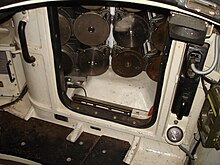
The ammunition for the cannon is located in the rear of the turret as well as in the tank hull. The ready-to-use ammunition behind a pressure-tight bulkhead door in the turret contains 15 cartridges (which can be of different types) and is accessible to the loader at any time. The 27 cartridges (from A6M reduced to 22 cartridges) in the tub (on the left of the driver in the direction of travel) are only accessible when the tower is in a certain position (3 o'clock - then lashed for safety reasons).
The Leopard 2 initially had two types of ammunition. The projectile used against enemy armored vehicle has the KE-ammunition (BW designation for K inetische E nergy, NATO designation APFSDS (-T) Armor Piercing Fin Stabilized Discarding Sabot tracer ), an armor piercing kinetic energy projectile with a sabot and tracer . Against hardened and soft targets, including infantry, the MZ-munitions (BW name for M honest Z wake ammunition, NATO designation HEAT -MP T High Explosive Anti Tank Multi Purpose - Tracer ), a shaped charge multipurpose projectile with tracer , used. Both types of bullets are wing stabilized. All types of ammunition consist of partially combustible cases, made of cellulose, nitrocellulose, resin and stabilizing additives and only leave the case base made of steel when fired.
With KE ammunition, a wing-stabilized arrow projectile with a caliber of about 38 millimeters made of sintered tungsten carbide is fired from the 120 mm smooth-barreled cannon with the aid of a sabot . The projectile has, depending on the type of ammunition and on-board cannon (DM 33 + L / 44), a muzzle velocity of 1640 m / s (i.e. about five times the speed of sound). The effect of the KE projectile is based on kinetic energy; it does not contain explosives; its effect is solely dependent on the energy it hits. After hitting the target and while penetrating the armor, the arrow displaces armor material due to its high kinetic energy. If it penetrates into the fighting compartment, it causes a rain of splinters on the inside. As the distance increases, the air resistance reduces the penetrator's speed and thus its kinetic energy and penetration performance.
The MZ bullet has a muzzle velocity of 1140 m / s. The speed has no noteworthy effect on the penetration power. This is due to the design of the projectile as a hollow charge projectile. As a result, the shooting distance also has no influence on the target effect. As a result of the extreme heat caused by the breakthrough, secondary explosions usually occur in the tank. Pressure and splinters of molten material act against the occupants. The penetration performance against homogeneous armor plates is around 600 millimeters for the MZ bullet and over 800 millimeters for the KE bullet.
Due to the improvements in the protection technology against shaped charge projectiles, Rheinmetall developed a HE projectile (high explosive grenade). It replaces the old and no longer produced MZ ammunition in the Bundeswehr and improves the effectiveness of the Leopard 2 against area targets, against positions behind cover, in shelters and buildings, against infantry, armored personnel carriers and lightly armored transport vehicles. The muzzle velocity of the 19 kilogram bullet is around 1100 m / s with the L / 55 and enables combat distances of up to 5000 meters. In addition to a time fuse, the ammunition also has an impact fuse with and without delay. The igniter is set either manually via a separate igniter setting device or automatically via a connection to the fire control computer. With the help of the time fuse it is possible to detonate the ammunition in the air at a predetermined distance from the target. The ammunition was introduced as DM11 in 2014. The unit price is around 9,000 euros.
In addition to this ammunition, the armed forces also have practice ammunition for the live shot. The Bundeswehr uses them for the KE and MZ transfer projectiles. Both are marked light blue. Due to the safety area of 90 kilometers for KE combat ammunition, the armored troops almost exclusively use the KE ammunition practice variant for live shots in Germany. The penetrator of the KE-Ub is made of a lighter material and has a perforated cone tail. Over the first 2,000 meters, the external ballistic properties largely correspond to those of combat ammunition; only at greater distances do there are rapidly increasing deviations. The safety area is 22 kilometers, with improved KE-OU ( APFSDS-T-TP, TP stands for Target Practice ) it is 7.5 kilometers. The MZ-Ub ( HEAT-T-TP ) is the same as the DM 12 A2 combat cartridge except for the warhead. This has a concrete head to reduce the damage in the target area and thus the costs.
In addition to the usual types of ammunition for the Leopard 2, Rheinmetall also advertised a retrofit kit called LAHAT , with which a further increase in performance is achieved. LAHAT is a laser-guided missile from Israel Aerospace Industries with an effective range of more than 6000 meters, which is fired from the on-board cannon or from a position-independent launcher. The improvement also includes a laser-based fire control system for weapon control. The rocket is insensitive to all known attempts to interfere and can be used against tanks, helicopters and targets out of sight of the crew.
In addition, PELE and canister ammunition are available depending on the user state .
| Surname | Type | Mass - cartridge in kg |
Mass - penetrator / bullet in kg |
Muzzle velocity in m / s |
Combat distance in m |
Introduction / note |
|---|---|---|---|---|---|---|
| DM12 | MZ | 23.2 | 13.5 | circa 1140 | approx. 2600 | 1979 |
| DM12A1 | MZ | 23.2 | 14.1 | circa 1140 | approx. 2600 | Successor to the DM12 |
| DM13 | KE | - | circa 1650 | approx. 3200 | 1979 | |
| DM23 | KE | - | circa 1650 | approx. 3500 | 1983 | |
| DM33 | KE | 19th | 4.6 | circa 1650 | approx. 3500 | 1987 |
| DM43 / DM43A1 (LKE I) |
KE | 20th | 7.2 with sabot | 1740 | - | International use |
| DM53 (LKE II) |
KE | 21.4 | approx. 5 | 1670 (L / 44) 1750 (L / 55) |
4000 | 1999 |
|
DM53A1 / DM63 (LKE II) |
KE | ? | approx 8.45 | 1750 (L / 55) | - | 2005 improved LKE II, stronger propellant charge; Increased effective shooting distance, shooting only from L / 55. |
| DM11 | HE | approx. 19 | - | approx. 950 (L / 44) approx. 1100 (L / 55) |
5000 | 2014 Can with a programming kit consisting of an "Ammunition Communication Module (ACM)" for programming the detonators, an interface (interface box) between the ACM and the fire control computer that generates all relevant data for the ACM and an additional switch box for the loader control unit (Add -on Control-Box / ACB) can be fired from every Leopard 2. |
Note: Ammunition used by the Bundeswehr
Armor

The Leopard 2 is protected by composite armor (also known as multilayer or composite armor ) of the third generation (C technology). The exact structure and the strength are subject to confidentiality and are based on the current development of weapon technology. The armor consists of a multiple bulkhead arrangement in which the spaces are filled with elastic rubber. Different types of steel with different degrees of hardness and composite materials such as ceramic, plastic or Kevlar can be used as materials. The structure follows the Chobham principle , but is not Chobham armor . Special emphasis was placed on strong front armor.
The hull and the tower are manufactured as a housing with integrated armor ; that is, the outer and inner armor plates also take on body functions in addition to protection. Within this load-bearing structure, the actual armor in the form of blocks is inserted into the intended cavities, which gives the armor its angular shape.
The wedge armor attached to the turret front since the Leopard 2A5 , on the other hand, was designed as spaced armor and has the task of increasing the depth of the armor, breaking KE penetrators and detonating shaped charge projectiles (HL) in front of the basic armor. For this purpose, the structure is usually divided into the destabilization stage (disturber), crushing stage (disrupter) and erosion stage (absorber). The often assumed ricochet of the projectiles does not occur, however, since KE ammunition of the 21st century is still effective at impact angles of 10 ° to 15 °.
The ammunition bunker in the rear of the tower has blow-out panels on the upper side in order to dissipate the energy of an explosion of the ammunition stored there to the outside. The interior of the armor is lined with fabric mats (spall liner) made of high-strength fibers such as aramid (Kevlar) in order to reduce or completely prevent the splinter cone when penetrating the armor.
In addition to these protective functions, the Leopard 2 has, depending on the operating country, other armor elements such as bomblet protection for the top, slat armor (a cage against HL bullets), extended mine protection (see A6M) or additional armor in the form of the composite armor from Mexico or AMAP from IBD Deisenroth Engineering (Deisenroth engineering office).
The various versions of the Leopard 2 have the following armor protection ( RHA equivalent) against HEAT and KE projectiles :
| Component | Leopard 2A1-A3 | Leopard 2A4 | Leopard 2A5 | Stridsvagn 122 |
|---|---|---|---|---|
| Tub front KE floors: |
350-550 mm | 600 mm | 620 mm | 620-780 mm |
| Tub front HEAT grenades: |
520 mm | 620-710 mm | 620-750 mm | 750-920 mm |
| Tower front KE storeys: |
500-550 mm | 590-690 mm | 850-930 mm | 920-940 mm |
| Tower front HEAT grenades: |
810 mm | 810-1290 mm | 980-1730 mm | 1290-1960 mm |
Drive and drive
The tank has a torsion bar sprung support roller running gear with lamellar dampers and hydraulic and mechanical end stops over the swing arms of the running wheel pairs. Its torsion bars are preloaded with 50 kN each. It has a "living" end connector crawler track with exchangeable chain pads from Diehl of the type 570 F (later FT). When driving in snow, on ice or to increase the grip of the chain, 18 chain cushions per side can be exchanged for cast iron snow grippers in a short time.
The Leopard 2 is of a liquid-cooled four-stroke V12 prechamber - multi-fuel engine of the type MTU driven MB 873-Ka five hundred and first With intercooling and two turbochargers fitted it makes 1100 kW (1500 hp) at an engine speed of 2600 rpm -1 and accelerate the tank to a top speed of officially 68 km / h. The real final speed to be achieved varies and can be up to 30 km / h higher depending on the surface. Overspeed from 2850 min −1 are prevented by the electronic engine control system (MKA). It is automatically switched off in the event of a critical coolant condition or oil level. For emergencies in combat situations, the MKA has a sealed bridging circuit. The maximum torque of 4700 Nm at 1600 min -1 achieved.
The unit comes from the Ka 500 engine program of the Kampfpanzer 70 development. In comparison, the Ka 501 has a larger displacement to 47.6 liters, which is reflected in a higher torque and load acceptance capability across the entire speed range and improved acceleration capability. The degree of separation of the combination air filter and the efficiency of the cooling system have been improved and increased stability. The pure multi-fuel capability was not pursued further during the further development by MTU Friedrichshafen, so that at least a fuel mixture of 60% diesel and 40% of another approved flammable liquid is necessary. A dry sump pressure circulation lubrication ensures an oil supply to all lubrication points even with an inclined position of 35 ° in the direction of the crankshaft and 25 ° across it. The supply lines to the vehicle are equipped with self-sealing quick release couplings. An oil-cooled 20 kW generator attached to the diesel engine via an intermediate transmission supplies the 24 V on-board network with electricity.
The combustion air required for operation is supplied through two combination air filters attached to the side of the engine. In them, the air sucked in through two circular intake ducts on the engine cover plate is cleaned and 95% of the coarse dust is freed via cyclone filters. This is then removed from the engine room by a coarse vacuum fan. Two further round fine filter inserts bind the remaining dust particles. The waste heat is dissipated via two temperature-controlled ring coolers with an integrated fan arrangement on the gear unit. These are separated from the motor by a rubber lip so that they can be rinsed with water when the immersion hydraulics are switched on. The fans are switched off during this time. In normal operation, the heated exhaust air is blown down through the large rear grating and used there to cool the hot exhaust gases; which are also ejected slightly diagonally downwards through two circular gratings. The exhaust system is equipped with non-return valves for underwater travel.
The hydromechanical shift, reversing and steering gear of the type Renk-HSWL-354 is used to transmit power to the chain. It combines the drive, steering and auxiliary drive as well as the brake system in one housing and is flanged together with the motor via quick-release devices to form the engine block. The drive is equipped with a hydrodynamic-mechanical 4-speed powershift transmission with a reversing stage. A mechanically bypassable torque converter is used as a low-wear power transmission in the lower speed range; the tank drives in converter mode. Above 1300 min −1 , an automatically closing lock-up clutch creates a fixed connection with which the engine power is transmitted like a rigid shaft. The service brake integrated in the transmission works in two stages. The tank is braked above 35 km / h by a wear-free hydraulic flow brake (hydrodynamic retarder ). Below this speed, the brake discs are activated with a pressure of> 98 bar. This enables a Leopard 2A4 to brake a distance of only 20.6 meters when the brakes are fully applied from 70 km / h.
As with its predecessors, the drive system is designed as a complete engine block, which enables the complete drive train to be changed with the support of an armored recovery vehicle within 15 minutes as part of a dynamic weapons show. However, many activities such as disconnecting the side gear or releasing the rear plate are already carried out in advance. A change according to the specifications of the technical service regulation is specified with four hours.
The relatively low fuel consumption of the Leopard 2 is also worth mentioning. Compared to the US M1 Abrams tank, which is often used as a comparison, with its Avco Lycoming AGT-1500 gas turbine, the consumption is around half. The diesel drive has the greatest advantage in idling and partial load operation .
A is for operating the electrical systems without running the main engine in the rear right hull rear auxiliary power unit (engl. Auxiliary power unit APU) installed. Depending on the user country, the diesel unit has an output of 7.5 kW to 17 kW. The batteries are charged and monitored in the Auto and Load operating modes . In the Continuous stage , the unit is in continuous operation; it takes over the complete supply and relieves the batteries.
crew

The Leopard 2 has a crew of four (commander, gunner, loader and driver). This is followed by a description of the job and the distribution of tasks for a German tank crew.
commander
The commander is responsible for the battle tank and its crew. In battle, he has to deal with a variety of tasks:
- Conducting radio communications with the platoon leader or company commander
- Reconnaissance of the battlefield and target assignment for the gunner
- Leading the battle tank in a platoon by giving instructions to the driver
- Conducting the fire fight by overriding the gunner (in emergency or duel situations)
- Determination of the type of ammunition to be used: (KE, MZ or MG)
This is only a selection of the most important functions; In addition, there are obligations to fulfill the deadline booklet (i.e. maintenance) and the checklist and thus to maintain the operational readiness of the tank. A multiple burden arises when the commander of the tank is platoon commander, company commander or battalion commander at the same time. He is then not only responsible for the elementary tasks in his own tank, but also has to take over the tactical coordination, i.e. movement, target assignment and fire clearance for the formation under him.
Gunner
The gunner is the deputy commander and, if he fails, must take over the relevant functions as far as possible. However, he is primarily responsible for leading the fire fight and observing the battlefield in his observation area. In addition, he must avoid damage to the tower by terrain or vegetation by moving the tower and the on-board cannon accordingly. Up to version A4, the gunner led the fire fight largely independently according to certain specifications, whereby first offensive units, for example battle tanks (then the use of ammunition was also directed), the commander could override the gunner in dangerous situations (aiming at a target, fought by gunner). As of version A5, the commander usually assigns the target to be fought to the gunner, as he has an observation facility (PERI R17) that is independent of the tower and enables him to have a 360-degree view without having to move the tower. However, if a duel situation occurs, i.e. if the gunner detects a target (for example an enemy main battle tank) that is about to fight his own tank, he is instructed to fight this target with the ammunition currently loaded without any further inquiry to the commander. As a secondary weapon, it uses the machine gun mounted axially parallel to the on-board cannon.
In addition to his duties in combat, he is responsible for fulfilling his points in the deadline booklet or in the checklist, i.e. he takes care of maintenance and care for the tower together with the commander.
Loader
The loader has the most physically demanding job in a battle: He has to remove the 120 mm cartridges from the ammunition bunker in the tower and use them to reload the on-board cannon. The often specified rate of fire of nine rounds per minute (realistically four to six rounds / minute) represents a very good performance by the loader, since even light terrain presents the loader with a physical challenge when conducting a fire fight while moving. In addition to reloading the on-board cannon, he is also responsible for the axially parallel MG3 and 7.62 mm FlaMG (anti-aircraft machine gun). Even if it is seldom or never used for the purpose originally intended, the loader also has the option of intervening in the fighting with the MG attached to his hatch. Like the commander and gunner, the loader is responsible for maintenance work on the tank. In addition, the loader is usually responsible as a guide for the tank and clears the tank for action, i.e. he removes the rotating beacon, covers the headlights, folds up the rear chain covers and removes the mud flaps.
driver
In contrast to the rest of the crew, the driver is accommodated in the front right of the tub and is practically isolated from the rest of his crew. He is the only member of the crew who can directly influence the movements of the tank and therefore has a special responsibility. In combat, he must guide the vehicle in such a way that it never occupies an exposed position, i.e. exposed to enemy fire. He has to have “an eye” for the terrain, spot the most favorable positions and position the tank there. The commander gives the driver basic marching orders or goals, the specific execution is left to the driver. Choosing the best driving movements is made more difficult by the severely restricted field of vision under the hatch (i.e. with the driver hatch closed). In certain emergency situations, the driver is instructed to evade independently, for example when artillery fire begins. For night combat, the driver can exchange the middle of his three corner mirrors for a night vision device . In addition, he is responsible for the maintenance of the entire hull including the engine and running gear, etc., whereby the other crew members, for example, help with adjusting the chain tension.
In civil road traffic, the driver is supported by the commander and loader; These help to assess the traffic situation, warn of overtaking vehicles or indicate following vehicles to keep more distance. In Germany, the driver has to drive over the hatch while driving on the road , i.e. the driver's hatch is open and he can see out above. The height of the driver's seat can be adjusted accordingly.
Operational experience
KFOR

On June 12, 1999, 28 Leopard 2A5s were deployed by the German Armed Forces when the KFOR troops marched into Kosovo . The vehicles of tank battalions 33 and 214 were sent from Macedonia to Prizren . They served as object protection and patrol vehicles and at the control and observation points as part of the Show of Force as security vehicles . The main battle tank appeared in the news in an incident on June 13, 1999 in which two Serb paramilitaries shot at one of these checkpoints in Prizren from a Lada . Since the crew was only partially on board, no shot was fired from the on-board weapons, but rather from dismounted forces from other vehicles. On the other hand, the on-board cannon was used on June 26, 1999, when the crew of a 2A5 fired four warning shots over the town of Orahovac . The problem with the use of the Leopard 2 was the insufficient load-bearing capacity of the bridges in the operational area.
Due to the decreasing threat level, the 2A5 were exchanged for a Leopard 2A4 at the turn of the year 2000/2001. Some A4 were also used during the 2001 riots in Macedonia . The battle tanks served as object protection vehicles for the Bundeswehr logistics warehouse there. Until the withdrawal at the end of 2004, the tanks were stationed in the Austrian-Swiss camp "Casablanca".
ISAF
Canada has been using 20 Leopard 2A6M-CANs in Afghanistan for ISAF operations since August 2007 . The entire crew survived a large booby trap attack on a Canadian leopard on November 2, 2007: “My crew came across an IED and went down in history as the first crew to test the ' M ' package. It worked as it should, ”wrote a Canadian officer to the German Defense Ministry, saying that there were probably no survivors in another vehicle. Only the driver of the tank suffered a hip fracture, the rest of the crew got away with bruises.
The chief of the Canadian General Staff, General Rick Hillier , responded to press reports and denied that the Leopard 2, damaged by the explosion, had been destroyed. Instead, the tank was repaired and is now back in action. "The Taliban attacked the new Leopard-2 tanks in several ambushes," and as a result the Taliban "learned some very hard lessons" and "lost the fight very quickly and very violently".
Denmark has also relocated a Leopard 2A5DK train to Afghanistan, where it is deployed in the Helmand province . On January 5, 2008, the tanks proved their worth in a first firefight in support of British troops against Taliban fighters . On February 26, 2008, a Danish Leopard 2 was hit by an explosive charge. A chain of the vehicle was destroyed, the crew was unharmed. Despite the destroyed chain, the tank was able to return to the camp on its own and be repaired there. On July 25, 2008, another Danish leopard was hit by an explosive charge in Afghanistan and the driver was killed. The 2A5DK did not have any additional anti-mine protection equipment at the time.
Euphrates shield
With the progress of the Turkish military offensive in northern Syria ("Euphrates shield") against Daesh (see Islamic State ) and after the M60 main battle tank and its further development, the Sabra, proved inadequate, the armed forces were reinforced by 50 Leopard 2A4s. They were used by the 5th Tank Brigade and the 172nd Tank Brigade of the Turkish 2nd Army . The use restrictions in Germany, which provide for the use of the Leopard 2 only for national defense, but not in Germany or against the PKK and therefore speak against a use in Syria, was lifted according to Turkish information in 2009 with mutual understanding.
The Daesh terrorist militia claims to have met at least ten Leopard 2A4s during the fighting over al-Bab and incapacitated them. An unverified list posted on the Internet shows ten tanks with failures. According to media reports, a tank is said to have been captured at the end of December 2016. Photos later appeared on the Internet that are supposed to prove that the tank had been destroyed - by an F-16 fighter aircraft of the Turkish Air Force . An official confirmation from the military leadership has not yet been received.
Olive branch
Leopard 2A4 tanks were used by the Turkish military in the fight against the YPG in the Afrin region of Syria in 2018 . The mission was confirmed to the German government . According to unconfirmed reports, a Leopard 2A4 was said to have been destroyed during the fighting by an anti-tank guided missile of the YPG on February 3, 2018 , killing five Turkish soldiers.
losses
Since the beginning of their invasion of Syria in 2018 ( Turkish military offensive on Afrin ), the Turkish armed forces have had to record an unknown number of their Leopard 2 A4s as total losses. It is speculated that at least ten Leopard 2A4s were either incapacitated or completely destroyed. Experts cited the reasons for this that certain weak points of the tanks were exploited by the enemy, for example by hits in the weaker side or rear armor and the lack of reactive armor or active distance protective measures .
LeoBen community
The further development of the weapon system to make Leopard and its family of vehicles on a common basis, was the Leoben-Community (1969 by Germany, Belgium, the Netherlands and Norway Leo pard- ben utzende States) was founded. Divided into several working groups and controlled by a steering committee, the objectives are to simplify supply, jointly develop the weapon system, simplify repairs, adapt the Leopard family to future threats and reduce costs.
variants
Variants of the Bundeswehr


The Bundeswehr has (as of August 2017) a total of 225 Leopard 2s in the versions A6 (155), A6M (50) and A7 (20). The 20 main battle tanks of this expansion stage that remained after the sale of 105 Leopard 2 A5s to Poland were taken out of service in order to avoid mixed equipment with different armaments.
The Leopard 2A4 disbanded units of the Bundeswehr were sold. Long-term storage that was common during the Cold War has been abandoned. Ten Leopard 2A4s have been demilitarized and are intended for exhibitions. The armaments companies Krauss-Maffei Wegmann and Rheinmetall Landsysteme also took over a few copies for internal tests and as base vehicles for possible conversions.
In April 2015, the federal government decided to increase the number to 328 vehicles. This will be achieved by buying back 100 tanks that are stored in the armaments industry. In a further step, a total of 104 Leopard 2 will be upgraded from 2019 and upgraded to the A7V level. This modernization measure includes all 20 Leopard A7s of the Bundeswehr, the 16 A6NLs made available by the Netherlands for the 414 tank battalion and 68 of the 100 Leopard A4s that were bought back. Eight vehicles are made available to the Federal Office for Equipment, Information Technology and Use by the Bundeswehr.
On March 20, 2019, the budget committee of the German Bundestag approved the retrofitting of another 101 Leopard A6 and A6Ms to a level comparable to the design of the A7V in order to adapt to the Leopard 2 A7V in terms of operation and logistics. Among other things, the Leopard 2 will receive a new target system, new radios and modified fire control computers. The renovation work should be completed by 2026. The number of Leopard 2 A7Vs (or comparable) then used in the Bundeswehr will then increase to 205 of a total of 328 planned Leopard 2s.
In the army, the tanks have been looked after in a dynamic availability management by the army repair logistics since mid-2014 and assigned to the troops if necessary. The A6 variants are used in the tank troops training center , in the Army Combat Training Center (GÜZ) and by the stabilization and intervention forces . The A7 is only available to the 203 tank battalion and the training center. The use of the Leopard 2A4 in the GÜZ as an enemy display vehicle and at the training center was discontinued in 2008. Occasionally, they were still used at the defense technology offices for technical testing.
| Construction lot | Construction year | variant | number of pieces |
|---|---|---|---|
| 1 | 1979-1982 | 2A0 | 380 |
| 2 | 1982-1983 | 2A1 | 450 |
| 3 | 1983-1984 | 2A1 | 300 |
| 4th | 1984-1985 | 2A3 | 300 |
| 5 | 1985-1987 | 2A4 | 370 |
| 6th | 1988-1989 | 2A4 | 150 |
| 7th | 1989 - 1990 | 2A4 | 100 |
| 8th | 1991-1992 | 2A4 | 75 |
Leopard 2AV
Prototype of the Leopard 2, also known as the austere version . In total, there were two chassis (PT 19, 20), three towers (T19, 20, 21) and a firing vehicle with the designation AV . The unit price in 1973 was around 2.3 million DM.
Leopard 2A0
First production version. Manufactured from October 1979 to March 1982 as the first construction lot with a total of 380 vehicles, 209 of them by Krauss-Maffei and 171 by MaK. The basic equipment consisted of the main EMES 15 rifle scope, a laser range finder, the PERI R17 panoramic periscope, the FERO Z18 tower rifle scope, an electro-hydraulic WNA-H22, a fire control computer, a cross wind sensor on the tower roof and a computer-controlled RPP 1-8 tank tester. Instead of a thermal imaging device possessed 200 vehicles of the batch over a residual light amplifier (PZB 200 = P assives Z IEL u. B eobachtungsgerät). Two chassis 10001 (KMW) and 20010 (MaK) served as training vehicles.
Leopard 2A1
Two construction lots with a total of 750 vehicles. The production of the construction lot 2 extended from March 1982 to November 1983 with 450 Leopard 2A1s, which was seamlessly followed by the third construction lot with the remaining 300 tanks. The final production was completed in November 1984. The main changes mainly comprised construction lot 2 and were: elimination of the cross wind sensor, standard thermal imaging device , uniform NATO standard for the ammunition holder of the main weapon, improved vehicle electrics, foot plates on the engine block, commander's periscope 5 centimeters higher, modified exhaust gas gratings , field cable connection point on the left rear of the tower, relocation of the tank filler neck on the side of the niche containers, enlargement of the cover of the intake hood for the protective ventilation system and rearrangement and crossing of the tow ropes at the rear of the vehicle. In construction lot 3, the main battle tank received detailed improvements in the interior.
Leopard 2A2
Retrofitting all 2A0s with a thermal imaging device . The PZB 200 is not applicable. The name changes to 2A2.
Leopard 2A3
Lot 4 with detail improvements. Installation of a new radio system SEM 80/90 (VHF) with shorter antennas, shortened pitot tube for the gunner's auxiliary rifle scope and now three-color camouflage. A total of 300 vehicles were manufactured between December 1984 and December 1985.
Leopard 2A4
The production of the Leopard 2A4 extended to four construction lots with 695 vehicles. The 5th construction lot began in December 1985 and ended in March 1987. The 370 Leopard had a digital ballistic computer for additional types of ammunition such as those used by the American armed forces, the ammunition hatch on the left side of the tower was omitted and an improved fire suppression system was installed. From the 97th vehicle, lot 6 of the series had improved armor protection for the turret and tub front, a new heavy chain apron, new chains from Diehl, low-maintenance batteries and maintenance-friendly idler covers. To protect the soldiers, the camouflage was changed to zinc chromate-free paint. The production of the 150 vehicles extended from January 1988 to May 1989. The construction lot 7 with 100 vehicles followed seamlessly and ended without changes in April 1990. From January 1991 the last construction lot 8 followed with 75 vehicles. The changes included an improved light and heavy chain apron in D technology - with a straight lower edge and only one stepping aid on the first segments - and a field adjustment mirror on the muzzle of the on-board cannon. The mirror was retrofitted on all vehicles. The construction lot ended on March 19, 1992 with the ceremonial handover of the last Leopard 2A4 produced by the Bundeswehr to the 8th Mountain Tank Battalion .
To standardize the design of the Leopard 2 fleet from 1995 on the level of the A4. The majority of the vehicles are mixed lots, consisting of tubs from the first construction lot and towers from the sixth to eighth construction lots. Two vehicles - chassis 11156 / tower 41164 (troop test model maximum); Chassis 11157 / tower 41265 (troop test sample minimum) - the eighth construction lot was used to test the Krauss-Maffei combat value enhancement program.
Troop test sample
In order to determine the extent of the planned increase in combat value, several test vehicles were commissioned by the Federal Office for Defense Technology and Procurement . The requirements of the BWB formulated in 1984 were implemented in the component test vehicle (KVT) in 1989. A series vehicle from the 5th construction lot served as the basis. The package, which was primarily designed for protection, comprised armoring of the hull and tower front as well as the tower roof with multi-layer armor of the 4th generation. The interior was lined with a splinter protection (Spall-Liner). An electric weapon tracking system replaced the hydraulic one and improved the passive protection for the crew by eliminating the hydraulic fluid. In order to eliminate ballistic holes in the armor, the driver was given a sliding hatch, the view of the EMES 15 was set higher. Other necessary changes, which primarily served the purpose of adaptation, were the relocation of the PERI R17 behind the commander's hatch, a new commander's corner mirror and an increase in the pretensioning of the torsion bars. The total weight increased by seven tons and reduced the specific power to 17.7 kW / t. The instrument test vehicle (IVT) created from the KVT - after successful testing - was used to test the Integrated Command and Information System (IFIS) in order to transmit situational information and the position of the battle tank.
The experience gained with the KVT was applied to two further series vehicles of the 8th construction batch in Troop Test Pattern 1 (TVM). The TVM-max (maximum requirement) and TVM-min (minimum requirement) were created between winter 1990 and autumn 1991. The two test models had the attachment modules on the tower and chassis, a bomblet protection on the tower roof, sliding hatches for the commander, driver and loaders, splinter protection in the fighting compartment, modified hydraulic end stops and the increased torsion bar pretension.
In some areas, however, different equipment was made and components from different manufacturers were installed. With the PERI-R17A2, the commander of the TVM-max had the Israeli thermal imaging device TIM 8-12 (El OP, since 2000 Elbit Systems), whose images were displayed on a monitor, the navigation was supported by an inertial navigation system. The directional drives of the tower were electric. With the PERI R17 TW, the TVM-min received a TV-based night vision solution with a large field magnifier and a GPS-supported navigation aid. The use of tip sights for the commander - with which the commander's panoramic periscope could be automatically swiveled to the corresponding area - was dispensed with. The armored hub caps of the drive and the laser first echo evaluation were also not implemented. The turret and weapon drive was carried out by means of enhanced electro-hydraulic directional drives.
From the winter of 1991 to the spring of 1992, both tanks were tested by the tank troop school in active service. The superiority of the electric directional drive quickly became apparent, the monitor viewing of the image output by the thermal imaging device was favored. The tip visors and the sliding hatches for the commander and loader turned out to be unsuitable for troops at the time.
The findings were discussed on March 30, 1992 to April 3, 1992 at the Federal Academy for Defense Administration and Technology in Mannheim by the three user states Germany, the Netherlands and Switzerland. The scope of the conversion corresponded to the following criteria: compliance with the financial upper limit of 1.18 million DM per vehicle, elimination of components with a high development risk and compliance with the loading weight of the heavy-duty transporter SLT-56 . The additional armor on the turret roof, the nose protection of the chassis, the splinter protection in the chassis and the tip visor were therefore not implemented. On the other hand, there was also the rear video camera for the driver. The configuration determined in this way was used with the Troop Test Pattern 2 - in some publications also as TVM 2 mod. - Tried in 1993, followed in 1994 by logistics trials at the Landsysteme Technical School and the Army Technical School for Technology . The design status during these follow-up examinations corresponded to that of the Leopard 2A5.
Leopard 2A5 KWS II
The Leopard 2A5 is the implementation of the combat value enhancement known as the Mannheim configuration (KWS) of level 2. Due to financing problems in the retrofitting in the Bundeswehr, the process was carried out in two lots; in 1995 to 1998 for lot 1 (225 vehicles) and 1999 to 2002 for lot 2 (125 vehicles). The changes to the 2A4 included additional armor on the turret front, light chain panels of the second and third generation (design in D-technology with straight lower edge), new commander's periscope PERI R17A2 with its own thermal imaging device (TIM, Thermal Imaging Module ), a digital computer, an electrical one Weapon tracking system, reversing camera and electropneumatic sliding hatch for the driver, Kevlar splinter protection (Spall-Liner) on the inside of the turret, armored hub covers for the rollers, installation of GPS and an inertial navigation system as well as preparation for the smooth-barreled L / 55 cannon. The tanks are exclusively conversions, consisting of the oldest towers (partly from the 1st lot) and the newest hulls from lots 6, 7 and 8. These are easy to see from the combination of the welded ammunition hatch on the tower and mostly six-part heavy chain covers on the Recognize tub. The reason for this was that not much had to be changed on the tub, only the driver's hatch was changed and the reversing camera was installed. The towers, on the other hand, were completely redesigned, so the oldest could be used here. The total costs were DM 347 million for lot 1 and DM 272 million for lot 2.
Leopard 2A6
The Leopard 2A6 is based on the KWS-I program from Krauss-Maffei, with which an increase in firepower should be achieved. The conversion of the tank therefore mainly concerned the weapon system. In detail, the barrel return brake and the trunnion bearing for the new 120 mm smooth-barreled L / 55 cannon were reinforced, and the fire control and weapon tracking system was adapted. The weighing pipe, smoke extractor, base piece and locking wedge were adopted from the old series gun. In contrast, the field adjustment system, the protective pipe cover and the case bag were completely renewed . 160 Leopard 2A5 and 65 Leopard 2A4, which were upgraded from the second KWS-II lot to the A6, served as the basis. On March 7, 2001, the first 2A6 was handed over from the manufacturer to the user and used in the 403 tank battalion.
In addition to these changes, a new KE ammunition was also introduced. The ammunition, known as LKE-II, penetrates up to 1000 millimeters of RHA , depending on the distance, and meets the requirements of the German armed forces for penetrating composite armor. The soiling of the field adjustment system when reversing, which has been known since the 2A4 version, turned out to be a problem. The armored troop school then tested front aprons (see Strv 121) with a modified tank (2A6 mod), which should prevent this. The new arrangement of the smoke thrower system was officially introduced with the 2A6M and installed with effect from May 2005 on all variants still in use during depot repairs.
Leopard 2A6M
The 2A6M corresponds to the 2A6 with additional mine protection. The conversion included the installation of a decoupled commander's and loader seat, a modified emergency exit hatch, an adaptable mine protection, torsion bar covers (to prevent them from flying around in a mine explosion), a cover for the slip ring assembly and a modified stowage of attached objects on the floor. A total of 70 of the 225 2A6s were modernized to the 2A6M stand.
The changes to the driver's position are particularly extensive and unusual. The conventional seat was removed and replaced by a Suspended Dynamic Seat . Developed by the company Autoflug , this seat with integrated harness is suspended from the vehicle ceiling via four straps, which decouples the seat and thus the driver from the rigid vehicle structure of the tank. Since these belts are attached to the vehicle ceiling via retractors (belt retractors), the driver can adjust his individual seat height (eye point) above and below the hatch almost continuously. The seat is then tensioned by further belts in such a way that the driver remains fixed in his position even in the event of a collision with another tank or when rolling over. With the help of a spacer cushion that is stowed away while driving, the driver can determine the necessary minimum distance to the ground. This is absolutely necessary, since the vehicle floor deforms both plastically and elastically during a stress acting under the tub, which has serious consequences if it is touched. Germany, the Netherlands, Norway, Sweden and Switzerland were involved in the development.
Combat value increase - level III
A KWS that had not been implemented was level 3. From 2008, the combat power of the Leopard 2 was to be increased by a 140 mm smooth-barreled cannon and an automatic loading system in the rear of the turret. The tower crew should be reduced to two men. At the same time, the installation of a computer system (Combat Forces Command and Control System IFIS) - in the parlance of the Bundeswehr as the command and weapon deployment system (FüWES) IFIS - and high-performance radio data transmission equipment should improve manageability. In 1995, the Federal Ministry of Defense discontinued KWS III at a planning meeting in Waldbröl . The funds were allocated to the New Armored Platform project .
Leopard 2 UrbOp
This variant of the Leopard 2 was a planned implementation of the PSO concept by Krauss-Maffei Wegmann for the German armed forces. The designation UrbOp stood for urban operations and at the same time denoted the required adjustments to the weapon system. The hulls of 150 Leopard 2A6M were intended as a chassis and were to be equipped with or prepared for PSO components. These included the clearing blade, improved front and side armor, the external intercom, the 360-degree camera system and the auxiliary power unit. Their A6 towers should be replaced by UrbOp modules when deployed. 50 A4 towers were planned, which would be reinforced with additional armor and upgraded with a remote-controlled weapon station, a guidance system (IFIS), the white light floodlight, a new PERI with an improved thermal imaging device and the air conditioning in the rear of the tower. The 120 mm smoothbore cannon L / 44 was still intended as a weapon system in the initial phase. The Leopard 2 UrbOp would therefore not be a new one, but a conversion and not always available. From July 2009 the experimental vehicle Leopard 2 PSO-VT was tested in this configuration. In contrast to the previous plans, he was armed with the L / 55 smoothbore cannon.
The original schedule was for the Leopard 2 to be upgraded accordingly from 2011 to 2018. KMW presented its final configuration under the name Leopard 2A7 + at the Eurosatory 2010 armaments fair . The Bundeswehr postponed the implementation of the PSO concept to 2019 and later discontinued it in favor of upgrading to the A7.
Leopard 2A7 / Leopard 2A7V

The Bundeswehr's Leopard 2A7 differs fundamentally from the KMW variant and is not optimized for combat in cities. So far, 20 Bundeswehr vehicles have been converted (as of February 2015). These are former Dutch vehicles that were returned to Germany from Canada. The original upgrade to the A6M was expanded in coordination with Canada and includes the tower-side unchanged combat compartment cooling system MKK6 from the Greek Leopard-2-A6M-HEL series, the completely newly developed energy generation system (EEA or APU) with a maximum electrical power output of up to 20 kW DC, based among other things on the 2-cylinder basic engine of the type "Steyr M12 TCA UI" (TCA UI = turbo charged, aftercooled , direct unit injection), the Barracuda camouflage system with heat transfer -System (SAAB BARRACUDA MCS with HTR CoolCam), the command and information system tried and tested in the troop test samples , on-board network optimization with UltraCaps in the chassis and tower area, a digital on-board communication system of the type SOTAS-IP as well as a renewal of the fire suppression system in the combat area and the retrofitting of the Attica -Thermal imaging module in the commander's optics. The weapon system is adapted for firing HE ammunition. In addition, the tank was prepared for the use of additional side armor. The first Leopard 2A7 was handed over to the German Armed Forces on December 10, 2014 in Munich. A total of 14 vehicles will be available to the tank battalion 203, four more are to go to the tank troops training center and one vehicle to the land systems technology training center . A reference vehicle is to remain at KMW. The combat weight reaches 62.52 tons.
In June 2016, KMW presented the next development stage of the Leopard 2A7V at the Eurosatory armaments fair. The demonstrator contains further improvements that were not ready for series production or could not be financed in the combat value enhancement program for the A7. Additional passive armor was added to the front of the hull, a third-generation thermal imaging device for the gunner, improved acceleration through modifications to the gearbox and side transmission, relocation of the NBC protection system to the rear of the turret to create space for a cooling device for the driver, the day and night vision system Spectus for the driver at the front and rear as well as an adaptation of the handgun holder and the stowage concept of the equipment. Overall, as part of the “Armored Combat Ability Development” initiative, the number of A7 vehicles in stock is to be increased from 20 to 104 vehicles.
When retrofitting the A7V and adapting the already built A7, the Federal Court of Auditors criticized that the terms of the contract were inadequate and would ultimately be at the expense of the taxpayer .
On May 5, 2017, a contract for the delivery of 104 Leopard 2s of the A7V variant was signed between the Federal Office for Equipment, Information Technology and Use of the Bundeswehr and Krauss-Maffei Wegmann as general contractor. The Bundeswehr's vehicle fleet is to increase to 328 A7Vs. The order volume is around 760 million euros, with Rheinmetall being the main subcontractors with 106.5 million euros and MTU Friedrichshafen with 21.2 million euros. In addition to the 104 A7V, the contract also includes a further 32 A4 chassis that are to be stored in order to form the basis for further vehicle variants. Delivery is planned between 2019 and 2023.
On March 20, 2019, the budget committee of the German Bundestag approved the retrofitting of another 101 Leopard A6 and A6Ms to a level comparable to the design of the A7V in order to adapt to the Leopard 2 A7V in terms of operation and logistics. Among other things, the Leopard 2 will receive a new target system, new radios and modified fire control computers. The renovation work should be completed by 2026. The number of Leopard 2 A7Vs (or comparable) then used in the Bundeswehr will then increase to 205 of a total of 328 planned Leopard 2s.
Variants Krauss-Maffei Wegmann
Leopard 2A6EX
The 2A6EX was a privately owned further development of the Leopard 2 from Krauss-Maffei Wegmann. A Leopard 2A4 from the eighth construction lot, which KMW converted in 1998/1999 as a presentation tank, served as the basis. The main battle tank, known in-house as Demo 1, was equipped with the Swedish Strv 122 with additional hull and turret armor, air conditioning, tip sights, hydraulic chain tensioners and an auxiliary unit. KMW presented its version of a combat enhancement program for the first time in 2002 at the Eurosatory military exhibition in Paris and Defendory in Athens. With Spanish markings, it also took part in the parade on October 12, 2002 on Spain's national holiday. The Spanish Leopard 2E and Greek Leopard 2HEL can be seen as a commercial counterpart.
Under the designation Demo 2, the battle tank was equipped with the smooth-barreled L / 55 cannon and the Euro-Powerpack as a drive. The Euro-Powerpack consists of the MT 883 diesel engine from MTU and the HSWL 295 TM gearbox from Renk. With the same power, it requires one meter less space in the engine compartment than the standard engine, but cannot be replaced without major changes to the pan. In addition, modifications have been made to the air duct to prevent incendiary devices from being drawn in; the heat radiation of the engine was reduced and a silencer was installed to reduce noise.
Leopard 2 PSO / 2A7 +
One of the most modern variants of the Leopard 2 is the Leopard 2 PSO ( Peace Support Operations ). Initially developed by KMW as a separate offer for deployments in local combat , so-called MOUT deployments (Military Operations in Urban Terrain), the PSO has been since the Tested and improved by the Bundeswehr in cooperation with the tank troops training center in Munster. As part of the Show of Force, it serves specifically for peacekeeping and peacekeeping measures. The complete equipment is modular and can be adapted as required. There is therefore no fixed configuration.
The hull of the Demo 2 presentation tank and a turret of the Leopard 2A5 served as the basis for the demonstrator. It was equipped with mine protection and additional passive all-round armor. As armament, he has the smooth barrel cannon L / 44 and a remote-controlled weapon station with an uncooled thermal imaging device on the rear tower roof. In 2002, KMW used the Autonomous Weapons and Observation Station (AWBS) from the WE program in Switzerland, which, however, was limited in terms of armament and was replaced by the unarmored FLW 200 with a Zeiss sensor box. Compared to the AWBS, the weapon station is lighter, more flexible in the weapon mount (for 5.56 mm to 12.7 mm machine guns or the 40 mm grenade machine weapon ) and has a larger elevation range.
The main battle tank was equipped with a clearing shield for obstacles and barricades. The shield, which comes from civilian production, has the same construction as a snow plow with floating position and is only used for clearing.
In order to be fully operational in all climatic zones, in all weather conditions and also at night, improved air conditioning systems ("combat room cooling system"), a stronger power supply and a 360-degree camera system (MiniSight from Cassidian Optronics (formerly Carl Zeiss Optronics, later Airbus DS Optronics)) integrated for all-round visibility - with thermal imaging device and day view for operations at night or in adverse weather conditions. Since the tank works closely with the infantry in local and urban combat and is intended to support them in their tasks, there is an externally accessible communication platform on the tank to enable the infantry to communicate with the tank crew as well as between the soldiers.
At the Eurosatory armaments fair 2010 KMW presented its final modification using a presentation vehicle under the name Leopard 2A7 + and with the advertising print; Developed by KMW - tested and approved by the German Federal Ministry of Defense ( developed by KMW - tested and qualified by German MoD ). In this presentation vehicle, only one side of the vehicle was equipped with the new armor, the left side of the vehicle from the driver's point of view was still on the Leopard 2A5 stand. The hull front was equipped with the additional armor known from the Strv 122, the underside of the hull had the mine protection of the Leopard 2A6M. The equipment of the 2A7 + was supplemented by a night driving system, combined with a residual light amplifier and thermal imaging device (SPECTUS from Cassidian Optronics) for the driver, as well as a new PERI RTWL commander's periscope derived from the Puma infantry fighting vehicle. The L / 55 was chosen as the on-board cannon in order to maintain the battle tank's ability to duel in symmetrical combat .
Variant IBD Deisenroth Engineering
In 2008, IBD Deisenroth Engineering presented its protection concept for main battle tanks under the name Leopard 2A4 Evolution . According to the company, it was developed for a foreign buyer, which was not specified at the time, that the AMAP armor was chosen and a demonstrator armored with it. The Leopard 2A4 variant was equipped with ballistic protection (AMAP-B) combined with AMAP-SC protection against shaped charge projectiles and extended mine protection (AMAP-M, AMAP-IED) as well as interior cladding, the liner (AMAP-L). The roof protection (AMAP-R) in the extension level 2 with a weight of 120 kg / m² protects against projectile-forming loads. The armored rear was provided with cage armor . AMAP-ADS was chosen as the distance-active protection system and integrated in 2009. The total weight of the demonstrator is 60 tons.
Rheinmetall Defense variant
In 2010, Rheinmetall's armaments division presented its application-oriented modular concept for the Leopard 2A4 at the Eurosatory armaments fair, which is marketed under the name MBT Revolution . The combat value increase, designed as a modular system, can be adapted to the respective requirements of the user. According to Rheinmetall, this applies to protection, active agents (ammunition), command and networking capabilities, and reconnaissance and vision systems.
The armor of the demonstrator was reinforced with the Evolution package from Deisenroth Engineering and thus offers IED side protection on the tower and hull, protection of the chassis and turret against KE ammunition, guided missiles and anti-tank weapons, roof protection against bomblets, extended mine protection and a Interior cladding against ingress of splinters and, through an active smoke protection system of the ROSY type, protection against TV, EO, IR , IIR , LASER and SACLOS guided weapons. The tower is completely digitized, which means that interfaces such as the laser range finder, commander's periscope and gunner aiming device have been improved; while saving space at the same time. The operating and control concept is automated and offers the crew an augmented reality that shortens reaction times and increases the first chance of being hit. Optionally, the tower can also be partially digitized while retaining the analog core system.
The commander's periscope was replaced by the SEOSS vision system from Rheinmetall. The optics, which are stabilized in two axes, have a thermal imaging device of the type sapphire, a laser range finder and an integrated fire control computer for six different types of ammunition. SEOSS allows target engagement even while driving, day and night, as well as with limited visibility. A Situational Awareness System (SAS) was installed for the all-round view in close proximity, which can automatically discover and track targets through two to four modules, each covering 3 × 60 °. An interface to the fire control system enables a connection to the remote-controlled Qimek weapon station and enables the crew to fight directly through the automated forwarding of captured target data.
Further upgrades include an air conditioning system, a power generator with 17 kW output and a management and information system from the INIOCHOS family. New and so far unique is the “Commander's Brake”, which can be used to fully or partially brake the tank. In addition, Rheinmetall offers a logistics and maintenance contract as well as suitable simulation and training systems.
Variant of Aselsan
In 2011, the Turkish armaments company Aselsan presented a self-financed concept of increasing combat value for the Leopard 2A4 under the name Leopard 2 Next Generation . The changes include a new fire control system including control devices, an electric tower and weapon drive, a remote-controlled SARP weapon station, a command and information system, a new fire extinguishing system, laser warning systems and a driver's vision system for day and night vision. All components are manufactured by Turkish companies. The AMAP package from Deisenroth Engineering is used as additional armor . The combat weight reaches 65 tons. According to the Turkish media, Finland was seen as a possible buyer of KWS in addition to Turkey.
Other leopard-based platforms
Further vehicles based on the Leopard 2 hull were introduced:
- Driving school tank Leopard 2
- Armored recovery vehicle Buffalo (BPz 3)
- Support vehicle Wisent 2 (a recovery and pioneering concept offered by FFG on a Leopard 2 chassis)
- Engineer tank Kodiak (PiPz 3)
- Panzerhaubitze 2000 (only the rollers)
- Bridge-laying vehicle for the armored rapid bridge 2
- Bridge-laying vehicle for the Iguana rapid-transit tank bridge
- ItPsv 90 Marksman anti-aircraft tank
Technical specifications
| designation | Leopard 2A4 | Leopard 2A5 | Leopard 2A6 / A6M |
|---|---|---|---|
| Type: | Main battle tank with self-supporting armored hull and welded turret | ||
| Crew: | 4th | ||
| Engine: | MTU twelve-cylinder diesel engine MB 873-Ka 501 with charge air cooling and two exhaust gas turbochargers | ||
| Displacement: | 47,600 cm³, speed: 2600 / min | ||
| Power: | 1103.25 kW (1500 hp) | ||
| Cooling: | Liquid-pump circulation cooling | ||
| Transmission: | Hydromechanical shift, reversing and steering gear HSWL 354 with combined hydrodynamic-mechanical service brake, 4 forward and 2 reverse gears | ||
| Landing gear: | Torsion bar sprung support roller running gear with lamellar dampers and hydraulic and fixed end stop dampers | ||
| Length over all on- board cannon at 12 o'clock: |
9,670 mm | 10,970 mm | |
| Width over everything: | 3,700 mm | 3,760 mm | |
| Height above everything: | 2,790 mm | 3,030 mm | |
| Ground clearance: | 540 mm, sloping towards the rear to 500 mm | ||
| Wading ability or structure: | 1,200 mm | ||
| Deep wading m. Deep water shaft: | 2,250 mm | ||
| Underwater driving m. Underwater drive shaft: | 4,000 mm | ||
| Trench crossing ability: | 3,000 mm | ||
| Climbing ability: | 1,100 mm | ||
| Gradeability : | 60% | ||
| Bank slope: | 30% | ||
| Empty weight: | 52,000 kg | 57,300 kg | 57,600 kg A6M 60,200 kg |
| Combat weight: | 55,150 kg | 59,500 kg |
A6 59,900 kg ( GVW 61,700 kg), A6M 62,500 kg |
| Specific ground pressure : | 0.83 kg / cm² | 9.3 N / cm² ([0.92 kg / cm²]) | |
| Design-related maximum speed: | 72 km / h; backwards 31 km / h | ||
| Fuel quantity: | 1,160 liters (limited to 900 liters in peace) | ||
| Turning circle: | 7 to 27 m depending on the aisle | ||
| Rotate around the vertical axis (360 °): | 10 seconds | ||
| Armament: | Rheinmetall 120 mm smoothbore cannon L / 44 and 2 machine guns | Rheinmetall 120 mm smoothbore cannon L / 55 and 2 machine guns | |
| Ammunition: | 42 cartridges, standard load including 30 balancing projectiles and 12 multi-purpose projectiles | 37 cartridges | |
| Tower weight: | 16 t | 21 t | |
| Straightening the tower: | 360 ° in 9 seconds (electric) | ||
| L / 44 | L / 55 (for A6) | |
|---|---|---|
| caliber | 120 mm | 120 mm |
| Pipe length: | 5280 mm | 6600 mm |
| Mass pipe: | 1190 kg | 1347 kg |
| Pipe attachments: | 50 kg | 65 kg |
| Mass weapon system: | 3780 kg | 4160 kg |
The Leopard 2 in other armed forces
In addition to the Leopard 2 battle tanks, which originally came from the Bundeswehr, new vehicles were also manufactured for states in addition to the Federal Republic of Germany.
| First delivery | number of pieces | variant | Users |
|---|---|---|---|
| 1981 | 445 | Leopard 2A4NL | Netherlands |
| 1987 | 380 | Pz 87 | Switzerland |
| 1995 | 120 | Strv 122 | Sweden |
| 2004 | 219 | Leopard 2E | Spain |
| 2007 | 170 | Leopard 2A6HEL | Greece |
| 2013 | 62 | Leopard 2A7Q | Qatar |
| 2018 | 44 | Leopard 2A7 + | Hungary |
Chile
The Chilean army has had the first Leopard 2 series battle tanks since November 14, 2007. The vehicles from the Bundeswehr's inventory were overhauled by KMW and converted to meet Chilean needs. During the contract negotiations, the number was increased several times. At the beginning it was 118, later the number increased to 140, then to 172. The purchase price is stated as 88 million euros. Around 140 tanks are in use, the rest are used as driving school tanks or spare parts donors. The contract also includes the delivery of special tools, test equipment and training support; the latter was carried out by the Bundeswehr from 2006 to 2008. A total of three battalions were equipped with the 2A4CHL. Dutch armored recovery vehicles serve as armored recovery vehicles , which the Flensburger Fahrzeugbau company has upgraded to become armored recovery vehicles 2000.
Denmark
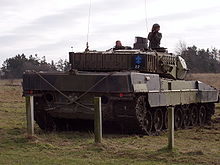
The Danish military was looking mid-1990s after a detachment of its Leopard 1A5 stocks. The missions at UNPROFOR , SFOR and KFOR determined the catalog of requirements and capabilities of the new battle tank. No practical tests were carried out with other country-specific kits, but among other things, the experience of Sweden was used.
The Danish combat troop school Haerens Kampskole in Oksbøl then recommended that the government buy the Leopard 2 with modifications. In December 1997, 51 Leopard 2A4s from the Bundeswehr's inventory were bought, the increase in combat value (KWS) was already roughly defined. The battle tanks were provided with Danish radios and Danish markings.
In accordance with the KWS program already planned, the vehicles were brought up to the 2A5DK level from 2002. The measures were a mix of the Mannheim configuration and the changes to the Swedish Strv 122. The tanks received the additional bow armor and the turret rear of the Strv 122, which was supplemented by the MKK3 air conditioning. They were the first Leopard 2 to receive the 10 kW additional unit (APU) in the right rear of the tub, which was slightly raised for this. The Israeli searchlight on the cannon mantlet was installed on the basis of experience with the UN operations to show possible conflict parties that they are under observation. An additional storage box and readiness brackets for the M96 rifle ( M16 derivative) were installed on the tower roof and the stowage concept for the equipment was adapted. After a restructuring of the armed forces in 2004, another 18 Leopard 2A4s were purchased from the Bundeswehr's inventory, six of which were upgraded to stand 2A5DK.
Like Sweden, after heat tests in Spain, the military decided to use the Barracuda camouflage system with heat transfer system ( HTC - Heat Transfer Reduction System ) in order to lower the interior temperatures and thus maintain the efficiency of the technology and crew. The 2007 Quick Reaction Force for Iraq and Afghanistan was the first to be equipped with it.
After the death of a soldier in an attack on one of the tanks used in Afghanistan, these were retrofitted with mine protection from IBD Deisenroth Engineering . The cage armor was also implemented . In addition to the usual KE and MZ ammunition, PELE and Canister are used as ammunition .
In 2016, the Danish military began preparations for the second upgrade of the tanks. The midlife update program was started in 2017. With the Factory Acceptance Test completed in 2019; The harmonization between the Danish Leopard 2A7 and the German Leopard 2A7V, the stowage system and the Danish electronic user interfaces were checked, and the official handover to the Danish army took place in October. A total of 44 tanks are to be upgraded to the 2A7 by 2022.
Finland
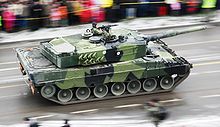
Between 2002 and 2003, Finland received German Leopard 2A4s from the Bundeswehr to replace the T-55 and T-72 GM1. Of the 124 battle tanks, six are used as bridge layers with the Iguana rapid-transit tank bridge (Leopard 2L; L = Iguana), six as mine clearance tanks (Leopard 2R; R = Raivaamis for break) and twelve to obtain spare parts. The 15 Leopard 2s bought at a later date are also used to obtain spare parts or as replacement vehicles.
The Leopard 2A4FIN corresponds technically to the German standard. In addition, the vehicles received additional storage baskets, the Tadrin VRC-959 radio, additional anti-slip coverings, a different three-color camouflage and modifications to the existing storage boxes. The flap of the EMES 15 received a small hole that allows the gunner to observe when the flap is closed. The LKE-2 is used as KE ammunition.
In January 2014, a supply contract for 100 A6NLs and a ten-year contract for the supply of spare parts were concluded with the Netherlands. In addition to the main battle tanks, ammunition, simulators and tools will be delivered between 2015 and 2019. Finland has been investigating the possibility of increasing the combat value of its existing Leopard 2 since June 2009. The British Marksman air defense system has been used on the Leopard 2 chassis since 2016 . Previously it was mounted on T-55AM until 2010 .
Greece

Greece is another NATO partner using the Leopard 2. In March 2003 the Greek government ordered 170 Leopard 2A6s with a total value of 1.7 billion euros from Krauss-Maffei Wegmann. The price also includes twelve Buffalo armored recovery vehicles, eight Iguana bridge-laying tanks on Leopard 1 chassis, two driving simulators and one shooting simulator as well as technical support and spare parts for two years. The vehicles correspond to the A6 design and are considered the most modern Leopard 2 at the time of delivery of the test vehicles from 2005 (series: 2006). So the tanks with air conditioning, have auxiliary power unit (Engl. Auxiliary power unit , APU), additional armor and country-specific equipment such as radios and camouflage. KMW manufactures a total of 30 tanks in Germany, the remaining 140 were manufactured in Greece by Hellenic Vehicle Industry ( ELBO ) until 2009 , which corresponds to an order volume of 557 million euros for the domestic armaments industry. The marking of the tanks is Leopard 2A6 HEL. Another variant used is the Leopard 2A4 from the German armed forces. Greece has a total of 183 tanks, 130 of which are being modernized by KMW and Rheinmetall Landsysteme. The changes include the repairs, a new camouflage, new radios and other small changes. As part of the retrofit, Rheinmetall Defense Electronics is also supplying electronic test equipment and command systems for battalion command posts and complements the depot test system in Velestino, Greece. Greece paid a total of 270 million euros for the purchase, which also included 150 Leopard 1A5s to bridge the gap until delivery of the A6.
It has been known since 2008 that KMW has outstanding claims amounting to 480 million euros from Greece. The company delivered 100 tanks, of which only 20 were paid for. According to the managing director Frank Haun, the lack of money increasingly caused liquidity bottlenecks.
However, according to the Greek media, payments to KMW were stopped because cracks were discovered in the tower hatches of 40 Leopard 2A6HELs. The Defense Science Institute for Materials and Operating Materials (WIWeB) of the BWB was commissioned to investigate the cracks. To fix the bug in the Leopard 2 made in Greece, the cracks are filled with resin and the damaged area is reinforced with a steel ring. The outstanding claims in August 2010 amounted to 100 million euros.
Indonesia
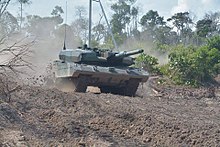
On May 7, 2013, the Federal Government ( Merkel II cabinet ) announced that the Federal Security Council had approved the delivery of 104 used Leopard 2s, four armored recovery vehicles , three bridge-laying armored vehicles and three pioneer armored vehicles as well as 50 older Marder models ( Marder 1A3 ) to Indonesia . In the summer of 2012, the head of state Susilo Bambang Yudhoyono met Merkel. The final delivery agreement with Rheinmetall includes 103 repaired and modernized vehicles of the A4 expansion stage. The contract, signed in December 2012, with a total value of 216 million euros, includes the main battle tanks, 43 overhauled Marder 1A3, 11 recovery and pioneer vehicles as well as the associated documentation, training equipment and logistics support as well as an initial set of training and combat ammunition. An upgrade with the Rheinmetall Revolution package is planned for 61 vehicles. The changes include the turret drive, ballistic protection, an auxiliary power unit, air conditioning, night and reversing aid for the driver and an adaptation of the weapon system to the HE ammunition.
Canada
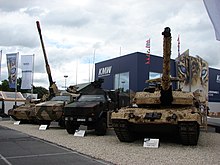
Canada has had the Leopard 2 since 2007 and decided against purchasing a wheeled armored vehicle with a 105 mm cannon. Originally, the M1128 Stryker MGS was supposed to replace the remaining Leopard C2, a variant of the Leopard 1 . The late operational readiness of the Stryker MGS and the positive experience with the Leopard C2 in southern Afghanistan since 2006 prompted the government to look for a successor. An inquiry to the German government in February 2007 resulted in 20 Leopard 2A6Ms and two armored recovery vehicles 3 being leased from the Bundeswehr's stocks for two years in order to cover the immediate requirements of the mission. The contract also included an agreement on logistical support for operations, including the training of Canadian tank crews and maintenance personnel by the German Armed Forces. The agreement, which originally expired in September 2009, was extended to the end of 2010.
The combat and recovery tanks were modified at Krauss-Maffei Wegmann and Rheinmetall Landsysteme , from where they were relocated to Afghanistan in August and September 2007 with the Strategic Airlift Interim Solution . The first Leopard 2 modified by Krauss-Maffei Wegmann was presented on August 2, 2007. The designation is Leopard 2A6M CAN.
On April 12, 2007, the Canadian Department of Defense announced that the Tank Replacement Project is to procure 100 surplus Leopard 2s (80 A4NL, 20 A6NL) worth $ 650 million from the Netherlands' inventory. The option to purchase 80 German A4s was not pursued. The conclusion of the contract in December of the same year sealed the purchase. The first Leopard 2s from the Netherlands then reached Canada at the end of 2008. A further twelve 2A4 vehicles were purchased from Switzerland in 2011. They serve as a platform for protected special vehicles.
The A6NL will be upgraded from Canada to the German A6M and will be returned to Germany instead of the leased vehicles. Instead of the originally planned conversion of 20 A4NL to the A6M CAN stand, preference was given to a hybrid solution. The aim of this concept is to get tanks for asymmetrical combat and symmetrical combat . The order to KMW was placed on June 16, 2009 and was implemented from July 2009 when the vehicles arrived. The modifications were carried out in the Kassel (tower) and Munich (Wanne) plants.
The first concepts with the designation 2A4 (Ops) CAN + defined the L / 55 on-board cannon, the electric turret drive, IED protection and armoring as possible modifications. The use of cage armor on the entire vehicle should be avoided, as this often turned out to be a disadvantage in use on narrow paths. In addition, they were to receive the standard C6 GPMG machine gun as secondary armament. For a further 42 A4NL, which are mainly used for training, a partial conversion was planned. The changes made by Rheinmetall Canada to these training vehicles were completed by the beginning of 2012 and brought the tanks to Canadian equipment standards. The total costs for modernization and repair are 17 million euros. The remaining vehicles, including the Swiss vehicles mentioned above, are intended to be converted into pioneer and recovery vehicles. These are 18 pioneer tanks (originally 13 + 5 more as an option in the Force Mobility Enhancement Program, which was triggered in 2012) of the Wisent 2 type and 12 upgraded armored recovery vehicles 3 (of which four (two as an option) from the Force Mobility Enhancement Program) .
On October 7, 2010 KMW handed over the first of 20 modernized main battle tanks. The final designation is Leopard 2A4M CAN and denotes Canada's tank variant for asymmetrical combat. The vehicles have the L / 44 on-board cannon, hydraulic chain tensioners, a storage box for hand weapons on the turret roof, a digital-electric turret drive and cage armor on the turret and hull rear. The additional armor on the turret sides, the turret front, the hull sides and on the top of the hull have the same level of protection as the 2A7 + . The tower attachment modules are again wedge-shaped.
As with the A6M, mine protection was implemented using a mine protection plate, torsion bar covers and seats that are decoupled from the floor. Armor elements behind the rollers additionally strengthen protection against mines. A system for electronic countermeasures (Electronic Counter Measure System - ECM), can interfere with the wireless and mobile frequencies to protect against remotely ignited improvised explosive device (radio controlled improvised explosive device - RCIED). The fire extinguishing system was converted from Halon to nitrogen and the commander's control unit, loader control unit and the central logic / main distribution of the fire control system were replaced by new systems. With a thermal imaging camera at the front and rear, the driver was given the opportunity to control the vehicle even in poor weather conditions. The Barracuda camouflage system with heat transfer system, as used in Denmark, is also used. In addition, cooling vests, air conditioning and radio equipment typical of the country are part of the equipment. The C6 GPMG is used as a shutter and anti-aircraft machine gun. The combat weight reaches 61.8 tons.
A pioneer device interface on the front for mine rollers, mine plows or snow blades extends the range of applications and allows the continued use of established systems.
The tanks for the symmetrical battle are secured with the A6M of the Bundeswehr. The tanks received an additional front plate, cage armor, the Barracuda camouflage system with heat transfer system, Canadian radios with antenna system, a storage box for the Diemaco C8 assault rifle ( M16 derivative) on the roof, a jammer (Counter-IED ) and a cooling hood for the EWNA. The air conditioning was not scaffolded as these changes would have been too extensive. The crew was equipped with cooling vests. As a secondary armament, it remained with the MG3, although the Canadian tank soldiers used the C6 GPMG as anti-aircraft defense in the country of deployment, since the hatch ring of the loader on the Leopard 1 and 2 is identical. A modification, which was only made in the country of deployment, allows the armed forces to use the attachment of the Leopard 1 in order to be able to use mine rollers, TWMP mine plows and the clearing blade on some Leopard 2s. In addition to the usual tank ammunition, Canada also fires grape ammunition .
As with the main battle tank, the leased Buffalo recovery tanks received an increase in combat value. The conversion included mine protection, ballistic protection, cage armor, the radio system typical of the country, cooling vests and a widening of the clearing and support shield.
The Leopard 2 were deployed by the Kandahar Task Force . In the early days, they were still used together with the Leopard C2, they were the operational reserve and quick reaction force of the Task Force (TF) in the forward military base Masum Ghar, Panjwai district . According to the Canadian Armed Forces, the tank has since been used in all major TF operations. The mission ended in 2011 with the withdrawal of the combat troops. The armed forces maintain a total of 112 Leopard 2 vehicles, which are divided into 20 A6M CAN, 20 A4M CAN, 42 A4 CAN (training vehicles), 12 armored recovery vehicles 3, and 18 Wisent 2 armored vehicles.
Qatar
In 2009 it became known that Qatar was planning to purchase 36 Leopard-2 tanks. The then black-red coalition of Germany agreed to this request. Arms deals of this kind with Arab states had not yet taken place out of consideration for Israel . Israel was informed in advance of the intention to sell, but there were no objections. In 2012, Qatar said it was interested in 200 Leopard-2 tanks.
On April 18, 2013, KMW issued a press release announcing the sale of 62 Leopard 2A7 + to Qatar. The armaments business, which also includes 24 self-propelled howitzers 2000, peripheral equipment, training facilities and services, has an order value of 1.89 billion euros. Around half of the units ordered had been delivered by the end of 2016.
Netherlands

On March 2, 1979, the Netherlands decided as the first foreign buyer to purchase the Leopard 2. The tanks corresponded to construction lots 2 and 3, but with a modified radio system, new smoke launch system (NL standard), Fla-MG, TMG from FN Belgium and BIV driving device from Dutch production. Due to the close cooperation between Germany and the Netherlands, a technology exchange also took place, the results of which were taken into account in the tank production of the German models. The procurement of the 445 vehicles was completed in July 1986. Due to the transformations in the army, 114 Leopard 2 (NL) were sold to Austria, 330 were converted to stand A5 (NL) as part of the KWS II program. As with the Bundeswehr, 180 Leopard 2 A5 (NL) were upgraded to A6 and 37 A6NL were sold to Portugal, as well as 20 A6NL and 80 A4NL to Canada, and 52 A4NL to Norway. The active population was around 73 A6NL. Ten Leopard 2A4NL were converted into the Kodiak pioneer tank by Rheinmetall Landsysteme . The Bergepanzer Büffel is also used with the country-specific equipment under the name Bergingstank 600kN . In April 2011 the Dutch government announced that it would stop using all Leopard 2s due to austerity measures. The tanks were sold to Finland .
With the subordination of the 43rd Dutch Mechanized Brigade to the German 1st Panzer Division , the country was given the opportunity to continue using the Leopard 2. The remaining 16 A6NL will be integrated into the German combat vehicle pool and upgraded to the A7 version. A total of one company is provided by the Netherlands in tank battalion 414.
Norway
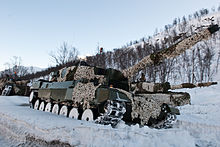
Norway bought used vehicles between 2001 and 2002 that were taken over from the Netherlands. The 52 Leopard 2A4NL replaced the decommissioned Leopard 1A1NO. The tanks received the original multiple throwing system and radio equipment typical of the country as well as on-board communication systems. In addition, a guidance system with appropriate radio data transmission and GPS antenna was integrated and a larger storage box was attached to the rear of the tower. The Leopard 2 designated as 2A4NO are also technically unchanged. A first increase in combat value was originally planned for 2009, but not started for unknown reasons. On April 23, 2015, the Norwegian Ministry of Defense published further plans to upgrade its tanks to the state of the art. The 1.7 billion US dollar program includes upgrading to networked operations management C⁴ISR as well as improving firepower, armor and mine protection. Also included is the upgrade of the CV-90 armored personnel carrier, which has been ongoing since April 2012, as well as the purchase of a new air defense system.
Austria
In 1996, the Austrian government decided to purchase 114 used Leopard 2A4s from the Dutch army as part of the Mech package and thus equipped three tank battalions of the German army . These were tanks that were built between December 1984 and December 1985 and delivered to the Dutch army as the Leopard 2A3. The feature of this series is the welded ammunition hatch on the left side of the turret. The vehicles were equipped with the Dutch smoke launch system, Dutch radio equipment and a Belgian 7.62 mm FN-MAG-MG for the loader. In the meantime, some vehicles have been equipped with a new smoke throw system and new antennas. The tanks were also equipped with the VIC-3-0 on-board intercom system from Rovis. In 2006 the number was reduced to two tank battalions and 40 of the surplus Leopard tanks were sold back to the manufacturer KMW in 2011. Canada, another interested party, was outbid.
Poland
The Polish Army has had the Leopard 2A4 since 2002. The 128 vehicles come from Bundeswehr stocks, most of them from the disbanded tank battalions 294 and 304. The overhauled tanks were introduced without any technical changes. The 2A4PL are deployed in the 1st and 2nd tank battalions of the Polish 10th Panzer Cavalry Brigade, which is one of NATO's crisis reaction forces. A contract to deliver a further 119 Leopard 2s, including 105 2A5 tanks, was signed by the respective defense ministers in November 2013.
Portugal
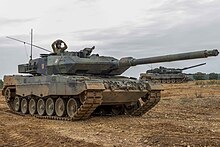
Portugal has had 37 Leopard 2 A6 from the Netherlands since 2008. The contract signed by the State Secretaries for Defense Cees van Kamp and João Mira Gomes in Lisbon in 2001 provides for training support, spare parts and ammunition to be supplied by the Netherlands in addition to the vehicles. The delivery was completed in 2009. Divided into three squadrons, the 2A6PRT will replace the M60A3 TTS main battle tanks .
Saudi Arabia
In the 1980s, the Saudi military intended to purchase the Leopard 2. However, despite the promises made by Helmut Schmidt ( Federal Chancellor until 1982) and Franz Josef Strauss , the deal did not materialize because the resistance within the federal government at the time proved to be too great. The federal government under Helmut Kohl stuck to its 1983 decision not to deliver the weapon system to a potential opponent of Israel.
Since July 2011, a corresponding preliminary inquiry from KMW had been submitted to the Federal Security Council . At the beginning of July 2011, the approval of the Federal Security Council for a possible export of two hundred Leopard 2A7 + to Saudi Arabia became the subject of a public debate, including in the German Bundestag . Opponents of arms exports referred to the human rights situation in Saudi Arabia , its undemocratic form of government and opposition to Israel, as well as the involvement of Saudi armed forces in the suppression of the protests in Bahrain in 2011 . The German government referred to the secrecy of the resolutions of the Security Council , the non-existence of objections to exports on the part of the Israeli government and the role of Saudi Arabia in the fight against terrorism .
In May 2012, intentions were announced that 200 to 300 tanks of the Spanish E variant would be bought from the arms company Santa Bárbara Sistemas. The arms deal initiated by King Juan Carlos is to be handled by the Spanish Ministry of Defense, which guarantees the maintenance of the tanks, supplies the necessary ammunition and is liable for any complaints.
According to media reports, Saudi Arabia wanted to buy up to 270 Leopard tanks worth at least five billion euros. According to media reports, the deal has now collapsed due to widespread criticism from the German public (as of July 2013). Instead, the country would purchase more M1 Abrams tanks from the United States.
Switzerland
During the development of the Leopard 2 in Germany, the Swiss Army investigated the possibilities of replacing their outdated Panzer 68/88 stocks. There were options to develop a new vehicle, to build a replica or to buy a foreign series vehicle. Under the leadership of the Contraves company (now Rheinmetall Defense ), the Swiss defense industry investigated the possibility of a new battle tank (NKPZ) . The project was discontinued on December 3, 1979. The risks of this new development and the associated costs were rated as too high. Thereupon two vehicles each of the M1 and Leopard 2 types were rented and tested. On March 9, 1981, the Leopard 2 were handed over from the Bundeswehr with slight changes. The vehicles were given a 71 mm Lyran apron lighting system and a VRC radio system with HX 101 A1 transmitting and receiving antennas. After extensive comparative tests - which lasted from August 1981 to June 1982 - it was decided to buy the Leopard 2. Reasons were, among other things, its earlier series production and the direct involvement of Swiss industry and thus a more cost-effective procurement than the M1. In May 1983, Contraves submitted an offer for the license building, which was approved by the Swiss National Council on December 11, 1984. The total number of items was 380 Leopard 2, 35 of which were to be produced directly at Krauss-Maffei. The remaining 345 were finished by the Federal Construction Workshop in Thun . The final designation was Panzer 87 Leopard.
The Panzer 87 corresponds to the construction level A4 of the fifth construction lot of the Bundeswehr. It differs in three additional brackets for ten snow grabs on the tower, a US vehicle radio system AN / VCR 12, Swiss Mg 87 , contour changes on the rear of the tower through an outboard intercom, hydraulic chain tensioners and a modified NBC protective ventilation system. A main feature is the exhaust silencer at the rear. This reduces the noise level and complies with EC directive 70/157. 25 Buffalo armored recovery vehicles and 12 Kodiak armored personnel carriers, which RUAG builds on surplus Leopard 2 chassis, are also used.
Since 2006 134 tanks have been subjected to a value maintenance program (combat value increase). The upgrades include improved command and control skills, a reversing camera with a driver display, an electric turret and weapon drive, and a new commander's periscope with thermal imaging device . The total cost is 395 million Swiss francs . The name changes to Panzer 87 Leopard WE. The weapon station planned in 2006 and the additional armor on the tower as well as the mine protection are not implemented. The Swiss Army also intends to procure the modern DM53 or DM63 ammunition. The entire delivery extends from 2008 to 2011.
Of the remaining tanks that had not been modernized, twelve were converted into engineering and mine clearance tanks. Another 42 units were sold to Rheinmetall at the end of 2010, where the tanks will also be converted into special versions and then exported.
Sweden
Another arms export is the Stridsvagn 121 and 122 to Sweden . From 1984 to 1987, the Swedish military sought a replacement for its 350 Centurions and the Stridsvagn 103 as part of the MBT-2000 program . The chosen path of in-house development Strv 2000 was given up in 1989 as too expensive.
The Swedish procurement office Försvarets materielverk (FMV) examined the Leclerc , the M1A2 Abrams and the Leopard 2 in the upgraded version from 1993 . The troop test model maximum (Leopard 2 improved) from the Bundeswehr program served as a model . After extensive driving tests and winter tests, the Leopard met 91% of the requirements, the Abrams 86% and the Leclerc 63%. In January 1994 the purchase agreement was signed, with 160 Leopard 2A4s (Stridsvagn 121) leased for 15 years. Israel Military Industries was chosen as the ammunition supplier.
The Stridsvagn 121 (120 mm cannon, first version) were unchanged Leopard 2 from construction lots 1 to 5 with the SEM 25/35 radio system of the Bundeswehr. The upgrade only included Swedish standard radios. The Stridsvagn 122 (120mm cannon, second version) is a much improved Leopard 2A5. The total number of vehicles is 120 vehicles with options for additional battle and recovery tanks. As with the Swiss Panzer 87, the majority of the vehicles were manufactured in the recipient country. Hägglunds and Bofors, currently (2006) BAE Systems , served as contractual partners, but Krauss-Maffei Wegmann remained the general contractor.
The Stridsvagn 122 differs from the 121 version in that it has additional overall armor ( MEXAS Heavy) on the front of the vehicle including bomblet protection for the tower roof, a guidance system ( Tank Command and Control System (TCCS)), modified chain covers and the GALIX smoke release system The fire control computer was expanded to twelve storage locations for the types of ammunition, the engine cooling system was changed to prevent the suction of incendiary devices and the torsion bars were adapted to the increased combat weight of 62.5 t. A front apron reduces damage to the field adjustment system and also reduces the formation of shadows. The Barracuda camouflage net system ( MCS; Multispectrum Cover System ) reduces the IR and heat radiation of the tank and breaks its contours.
The Stridsvagn 122B version has the additional mine protection and has been stored. The combat weight is 65 t. With the name Bärgningsbandvagn 120 the Bergepanzer Buffalo is also used. Significantly modified, the 14 performance-enhanced variants have the TCCS, GPS, a rear recovery device, a reversing camera, an additional winch, liner for the fighting area and the GALIX smoke release system.
Singapore
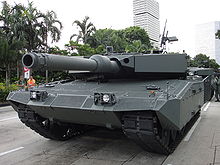
Singapore has had the Leopard 2 since mid-2007. The used 2A4s come from the German armed forces and replace the AMX-13 . Originally, when the contract was signed at the end of 2006, a total of 96 vehicles, 30 of which were for spare parts, was agreed. With the influx of emergency vehicles, the number was increased, so that at that time 102 battle tanks were in service. In May 2014 it became known that more tanks of this type had been exported to Singapore since 2012. The number of items in this delivery was classified by the Bundestag as CONFIDENTIAL and sent to the secret protection office of the German Bundestag . According to the Stockholm International Peace Research Institute, this increased the total to 182 battle tanks. The vehicles with the identification Leopard 2SG have the FN MAG machine gun from FN Herstal , a power generator set in the rear of the hull, an electric tower drive, an improved smoke launch system, country-specific radio equipment and a command and information system. The Leopard 2 was used for the first time during the Wallaby exercise in Australia at the end of 2008. To increase the protection concept, the tanks were retrofitted with the Evolution package from IBD Deisenroth Engineering and presented to the public on Singapore's national holiday in 2010.
Armored recovery vehicles and bridge layers on Leopard 2 chassis are also in use. The armored recovery vehicles (Leopard Armored Recovery Vehicle - LARV) and Armored Vehicle-Launched Bridge (L2-AVLB) are based on converted A4 battle tank hulls, with the armored recovery vehicles being the first conversions made by Rheinmetall. The LARV look similar to the Bergepanzer 3, but differs fundamentally from the German model in terms of the smoke release system, the lighting system at the front and rear and the superstructures. The combat weight reaches 63 tons. The bridge-layer is equipped with the LEGUAN armored rapid bridge , which has a load-bearing capacity of up to the military load class MLC 70.
Spain
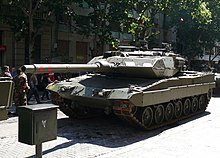
In the mid-1980s, Spain was looking for a new battle tank to be developed by German companies. The arms company Krauss-Maffei designed a 49-ton tank with a 120-mm smooth-barreled cannon under the working term Lince , which externally resembled the Leopard 2. With this concept, the company participated in the 1984 public tender, in which GIAT ( AMX-40 and LECLERC), General Dynamics (M1 Abrams), Vickers (Valiant) and Oto Melara (C-1 Ariete ) also took part. After another ten years in which no decision was made, talks on the sidelines of the ministerial meeting of the Western European Union (WEU) in Noordwijk (Netherlands) in November 1994 brought renewed movement towards the purchase of a new main battle tank for Spain. A letter of intent was signed, which provided for 108 Leopard 2s to be loaned over a period of five years and, from 1998, the purchase of 390 new Leopard 2s. Due to a lack of budget and the privatization of the state armaments company Santa Bárbara Sistemas , the purchase intention was not implemented. In 1998, two years later, the Spanish cabinet decided to purchase 219 Leopard 2E and 16 armored recovery vehicles 3 and to take over 108 Leopard 2A4s from the Bundeswehr. Santa Bárbara Sistemas acted as general contractor.
The business suffered another setback in 1999 after the takeover of Santa Bárbara Sistemas by the US company General Dynamics. Krauss-Maffei and the German federal government feared that German technology would be sold out. Due to the takeover, production began in 2003; this extended into 2008.
The structure of the Leopard 2E corresponds to the Leopard 2A6 of the German Armed Forces, but has numerous improvements and changes using the available technology. The tank has the L / 55 smoothbore cannon, a 2nd generation thermal imaging device from Raytheon for the commander and gunner, a new track, radios from Thales, a cooling system in the rear of the turret, a power generator on the right in the rear of the hull, an improved night vision device for the driver , a guidance and information system LINCE ( Leopard Information and Communication Equipment ) tailored to Spanish requirements and additional hull and turret armor.
Turkey
In 1999 it was announced that Turkey intended to purchase 1000 Leopard 2s. Krauss-Maffei Wegmann then submitted an export application to the federal government, which led to a serious coalition crisis ( SPD / Bündnis 90 / Die Grünen ). The coalition partner Bündnis 90 / Die Grünen refused to agree to an export. Winfried Nachtwei , a defense expert for the Greens, told the daily Die Welt that a delivery would be viewed by the Kurds as a "mistrust-building measure", "and so something like that would not fit into the reform process in Turkey". As a result, it was decided to give Turkey the demo 1 presentation tank (1999 a 2A5) from KMW for comparative testing, the use of which was limited in time, which was expressly stated on November 29, 1999 in a meeting of the German Bundestag by Ruprecht Polenz (CDU / CSU) with the words "He's coming back!" The planned purchase did not materialize.
After comparative tests in eastern and central Anatolia in 2001, the Turkish army decided to prefer the Leopard 2 to the alternatives from the USA (M1A2 Abrams), France (Leclerc) and the Ukraine ( T-84-120 Yatagan ).
On November 11, 2005, the German government announced that 298 Leopard 2A4s from the Bundeswehr would be delivered to Turkey. The reason given was the positive change in Turkey. The order volume was 365 million euros, of which around 70 million euros went to the German armaments industry for the modernization of tanks. The deal was completed in 2007. A further 56 A4 vehicles followed between 2010 and 2013. This increased the total to 354 vehicles. In mid-2007, however, Turkey decided to procure the other planned battle tanks to manufacture the South Korean K2 Black Panther under license. The project runs under the name " Altay ". For the existing Leopard 2A4, a combat value enhancement program with a total value equivalent to the equivalent of 500 million US dollars was tendered at the end of January 2017, for which Aselsan is applying.
A government official stated that current combat enhancement measures specifically target "active protection systems" against anti-tank weapons. The program was given priority after several Turkish Leopard 2A4 main battle tanks were damaged or destroyed by the ISIS terrorist militia during the Euphrates shield military operation in Syria.
Hungary
On December 19, 2018, a contract for the delivery of 44 newly manufactured Leopard 2A7 + tanks and 24 new self-propelled howitzers 2000 was signed with the German arms company Krauss-Maffei-Wegmann (KMW). The Leopard 2A7 + tanks are to replace the old T-72 stocks. In addition, another 12 used Leopard-2A4s from KMW's inventory are to be delivered as training vehicles.
literature
- Walter J. Spielberger: Waffensysteme Leopard 1 and Leopard 2. (= Military vehicles. Vol. 1) Completely revised and supplemented edition, Motorbuch-Verlag, Stuttgart 1995, ISBN 3-613-01655-9 .
- Michael Scheibert: Leopard 2 A5. Euro-Leopard 2. (= Waffen-Arsenal. Special. Bd. 17) Podzun-Pallas Verlag, Wölfersheim-Berstadt 1996, ISBN 3-7909-0576-3 .
- Andrew Jaremkov: Battlefield Hazards. Steel Beasts Manual. eSim Games, Mountain View CA 2001.
- Paul-Werner Krapke: Leopard 2. Its becoming and its performance. Self-published, sl 2004, ISBN 3-8334-1425-1 .
- Frank Lobitz: Leopard 2 main battle tank. Development and use in the Bundeswehr. = Leopard 2 main battle tank. Tankograd Publishing - Verlag Jochen Vollert, Erlangen 2009, ISBN 978-3-936519-08-2 .
- Frank Lobitz: Leopard 2nd battle tank. International use. = Leopard 2 battle tank. Tankograd Publishing - Verlag Jochen Vollert, Erlangen 2009, ISBN 978-3-936519-09-9 .
Web links
- Krauss-Maffei Wegmann website
- Website of the German Army on Leopard 2
- Leopard 2A4 in the Austrian Armed Forces
- Website about the Swiss tank 87 Leopard
- Stefan Kotsch: The fire control system of the Leopard 2 main battle tank . In: kotsch88.de .
- Bundeswehr Classix: The new Leo 2 (1978) . In: YouTube . May 22, 2015. (Video; 5:13 min)
- Bundeswehr: 60 seconds Bundeswehr: Leopard 2A6 . In: YouTube . July 25, 2018. (Video; 1:08 min)
Individual evidence
- ^ A b c Frank Lobitz: Leopard 2 battle tank. Development and use in the Bundeswehr . Tankograd Publishing - Verlag Jochen Vollert, Erlangen 2009, ISBN 978-3-936519-08-2 , technical data Leopard 2, p. 315 .
- ↑ Online editorial office of the Heer: Kampfpanzer Leopard 2. In: deutschesheer.de. May 8, 2012, accessed July 30, 2012 .
- ↑ Rolf Hilmes: Main battle tanks today and tomorrow . Motorbuch, Stuttgart 2007, ISBN 978-3-613-02793-0 , p. 40-42 . "The average consumption of the Leclerc fleet under the conditions of a troop trial by the Swedish army with 1380 liters per 100 kilometers was well above that of the Leopard 2 with 720 liters"
- ^ Bettina Berg: Minister de Maizière approves conversion. In: bmvg.de. October 21, 2011, accessed July 30, 2012 .
- ↑ a b Leopard 2. Bundeswehr buys back 100 battle tanks. In: zeit.de. April 10, 2015, accessed April 10, 2015 .
- ↑ Florian Flade: Bundeswehr equipment. Bomb-proof through Afghanistan in the "Leopard". In: Welt Online. Springer, April 16, 2010, accessed July 30, 2012 .
- ↑ Turkey confirms use of German tanks against Kurds orf.at, January 29, 2018, accessed January 29, 2018.
- ^ A b William W. Keller / Janne E. Nolan: Mortgaging Security for Economic Gain: US Arms Policy in an Insecure World . In: International Studies Perspectives . No. 2 , 2001, p. 182 .
- ↑ See Edelfried Baganski: Combat strength comparison of German tanks 1918 to 1989. In: Komitee Nachbau Sturmpanzerwagen A7V in cooperation with the Military History Research Office (publisher): Sturmpanzerwagen A7V. From the original tank to the Leopard 2. A contribution to the history of the military and technology. Herford 1990, p. 354.
- ↑ See Edelfried Baganski: Combat strength comparison of German tanks 1918 to 1989. In: Komitee Nachbau Sturmpanzerwagen A7V in cooperation with the Military History Research Office (publisher): Sturmpanzerwagen A7V. From the original tank to the Leopard 2. A contribution to the history of the military and technology. Herford 1990, p. 354.
- ^ Frank Lobitz: Leopard 2 battle tank. Development and use in the Bundeswehr . Tankograd Publishing - Verlag Jochen Vollert, Erlangen 2009, ISBN 978-3-936519-08-2 , p. 68 .
- ↑ Paul-Werner Krapke: Leopard 2. His becoming and his performance . ISBN 3-8334-1425-1 , pp. 35 .
- ↑ Paul-Werner Krapke: Leopard 2. His becoming and his performance . ISBN 3-8334-1425-1 , pp. 66 .
- ↑ See Edelfried Baganski: Combat strength comparison of German tanks 1918 to 1989. In: Komitee Nachbau Sturmpanzerwagen A7V in cooperation with the Military History Research Office (publisher): Sturmpanzerwagen A7V. From the original tank to the Leopard 2. A contribution to the history of the military and technology. Herford 1990, p. 355.
- ↑ Paul-Werner Krapke: Leopard 2. His becoming and his performance . ISBN 3-8334-1425-1 , pp. 48 .
- ↑ "No scrap iron for a long time" on y-punkt.de ( Memento from July 28, 2016 in the Internet Archive )
- ↑ tagesschau.de ( Memento from May 24, 2015 in the Internet Archive )
- ^ Walter J. Spielberger: The Leopard battle tanks and their varieties. Motorbuch Verlag, Stuttgart 1988, pp. 213, 237.
- ↑ a b c d e Frank Lobitz: Leopard 2 battle tank. Development and use in the Bundeswehr . Tankograd Publishing - Verlag Jochen Vollert, Erlangen 2009, ISBN 978-3-936519-09-9 , Leopard 2 technical description, p. 75 to 102 .
- ↑ Hand weapons of the Bundeswehr. Retrieved July 14, 2018 .
- ↑ CASSIDIAN - Defending World Security: New "eye" for the leopard. (No longer available online.) In: cassidian.com. January 22, 2013, archived from the original on February 2, 2014 ; Retrieved January 23, 2013 .
- ↑ Rheinmetall wins a major ammunition framework agreement from the Bundeswehr. In: Rheinmetall. Retrieved June 10, 2018 .
- ↑ a b Frank Lobitz: Leopard 2 battle tank. Development and use in the Bundeswehr . Tankograd Publishing - Verlag Jochen Vollert, Erlangen 2009, ISBN 978-3-936519-08-2 , The ammunition of the 120 mm smooth barrel cannon, p. 242 .
- ↑ Lahat Leopard 2. In: army-guide.com. Retrieved March 10, 2013 .
- ↑ Rolf Hilmes: Main Battle Tanks Today and Tomorrow: Building Technology of Main Battle Tanks . Motorbuchverlag, ISBN 978-3-613-02793-0 .
- ↑ Porsche or Panzer - who is faster? (PDF, 5MB) (No longer available online.) In: Auto Bild. November 21, 1997, archived from the original on August 12, 2011 ; Retrieved July 30, 2012 .
- ↑ Paul-Werner Krapke: Leopard 2. His becoming and his performance . ISBN 3-8334-1425-1 , pp. 74-77 .
- ^ Kosovo: shooting at the German checkpoint. In: Spiegel Online. June 14, 1999, accessed July 30, 2012 .
- ↑ a b Frank Lobitz: Leopard 2 battle tank. Development and use in the Bundeswehr . KFOR deployment in Kosovo 1999. Tankograd Publishing - Verlag Jochen Vollert, Erlangen 2009, ISBN 978-3-936519-08-2 , pp. 229 ff .
- ^ Murray Brewster: Germany gets thank-you note from Canadian IED survivor. (PDF; 16 kB) In: CNEWS. Qubecor Media, December 5, 2007, accessed July 30, 2012 .
- ↑ Involuntary mine test: Canadian thanks for German Leopard tanks . In: FAZ . No. 269 , November 19, 2007, pp. 8 ( online [accessed July 31, 2012]). Involuntary mine test: Canadian thanks for German Leopard tank ( Memento from November 5, 2012 in the Internet Archive )
- ^ Alan Freeman: Tank hit by IED back in service: Hillier. (PDF; 42 kB) In: The Globe and Mail . December 8, 2007, accessed July 30, 2012 .
- ^ Afghan stories: Danish tanks arrive in Afghanistan. In: LiveLeak.com. November 21, 2007, accessed July 30, 2012 .
- ↑ Article on CASR.ca. In: Simon Fraser University. Archived from the original on February 22, 2008 ; accessed on July 30, 2012 (English).
- ↑ Eckart Lohse: Afghanistan: leopard hunt in the Hindu Kush. In: FAZ. Frankfurter Allgemeine Zeitung GmbH, March 22, 2008, accessed on July 30, 2012 .
- ↑ Dansk soldier dræbt og tre lettere Saret i Afghanistan. (No longer available online.) In: Forsvaret Forsvarskommandoen. July 25, 2008, archived from the original on November 5, 2012 ; Retrieved July 30, 2012 (Danish).
- ↑ Darbe girişiminde kullanılan tanklar Suriye'de. In: haberturk.com .
- ↑ War with second-hand tanks from Germany? In: sueddeutsche.de .
- ↑ TSK O Tanklarla Suriye'ye Girebilir mi. In: tarafsizhaber.com .
- ↑ Almanya'dan, Leopard tanklara 'PKK'yı vur' izni. In: t24.com .
- ↑ Gernot Kramper: How this Leopard tank survived a missile hit. In: stern.de . January 22, 2018, accessed May 3, 2020 .
- ↑ Almanya'nın gururu Leopard 2 model tanklar nasıl vuruldu? In: ikelibaher.com .
- ↑ Gerhard Hegmann: IS fighters destroy the German tank myth. Welt / N24 of January 12, 2017.
- ↑ Al-Bab: 16 Turkish soldiers perished. In: dailysabah.com. December 22, 2016, accessed January 7, 2017 .
- ↑ Captured by the Turkish army: German Leopard tank falls into the hands of the Islamic State - video. In: Focus Online. December 23, 2016, accessed January 7, 2017 .
- ↑ German Leopard tanks in the hands of the IS militia. In: sueddeutsche.de .
- ↑ Turkey confirms federal government use of Leopard tanks. Retrieved February 4, 2018 .
- ↑ That was what was left of the German Leopard tank after a missile hit. Retrieved February 6, 2018 .
- ↑ https://www.youtube.com/watch?v=-7qkCTt7p_E
- ↑ Gerhard Hegmann: Syria: Leopard 2 losses scratch the German tank myth . In: THE WORLD . January 12, 2017 ( welt.de [accessed November 24, 2018]).
- ↑ How this Leopard tank survived a missile hit . In: stern.de . January 22, 2018 ( stern.de [accessed November 24, 2018]).
- ↑ FOCUS Online: He was considered indestructible: In Syria, a tank myth is destroyed - video . In: FOCUS Online . ( focus.de [accessed on November 24, 2018]).
- ↑ LEOBE. In: deutschesheer.de. Archived from the original on June 4, 2009 ; Retrieved July 30, 2012 .
- ↑ Answer of the Federal Government to the minor question from MPs Jan van Aken, Christine Buchholz, Wolfgang Gehrcke, other MPs and the DIE LINKE parliamentary group. (PDF) German Bundestag, September 11, 2013, accessed on August 10, 2017 .
- ↑ a b Info letter from the Army. (PDF, 1.1 MB) (No longer available online.) Förderkreis Heer e. V., March 1, 2012, formerly in the original ; Retrieved July 30, 2012 . ( Page no longer available , search in web archives )
- ↑ a b c d e Frank Lobitz: Leopard 2 battle tank. Development and use in the Bundeswehr . Tankograd Publishing - Verlag Jochen Vollert, Erlangen 2009, ISBN 978-3-936519-08-2 , Demonstrator Leopard 2A6EX 'Demo1' and 'Demo2', p. 274-283 .
- ↑ a b c d e f g h i j k l m n o p q r s Frank Lobitz: Leopard battle tank 2nd international deployment . Tankograd Publishing - Verlag Jochen Vollert, Erlangen 2009, ISBN 978-3-936519-09-9 .
- ↑ Major order for Rheinmetall: 104 Leopard 2 battle tanks of the Bundeswehr are brought up to date. (No longer available online.) In: rheinmetall-defence.com. September 27, 2017, archived from the original on October 3, 2017 ; accessed on October 3, 2017 .
- ↑ 428 million euros for national and alliance defense. In: Federal Ministry of Defense. March 20, 2019, accessed April 27, 2019 .
- ^ Information on the realignment of the army (INAH) 15th edition. (PDF; 475 kB) (No longer available online.) PIZ H Referat StratKom, Strausberg, October 1, 2014, archived from the original on January 2, 2015 ; accessed on January 2, 2015 .
- ↑ a b Jon Hawkes: Top cat: Leopard 2 MBT turns 40, as new variants continue to roll on . In: Daniel Wasserbly (Ed.): Jane's International Defense Review . tape 52 . Jane's by IHS Markit, Coulsdon, Surrey October 2019, p. 55-61 .
- ↑ a b c d e f g h i j Walter J. Spielberger: Weapon systems Leopard 1 and Leopard 2. (= military vehicles . 1 number row = 1). completely revised and expanded edition. Motorbuch-Verlag, Stuttgart 2003, p. 242 ff .
- ↑ Paul-Werner Krapke: Leopard 2. His becoming and his performance . ISBN 3-8334-1425-1 , 2.6.22 The technical change to the series status, p. 42 .
- ↑ Paul-Werner Krapke: Leopard 2. His becoming and his performance . as well as the further development of the Leopard 2, KWS - level 2 . ISBN 3-8334-1425-1 , Appendix, pp. 4 .
- ↑ a b Frank Lobitz: Leopard 2 battle tank. Development and use in the Bundeswehr . Tankograd Publishing - Verlag Jochen Vollert, Erlangen 2009, ISBN 978-3-936519-08-2 , KWS II - On the way to the Leopard 2A5, p. 153 ff .
- ↑ a b c d Frank Lobitz: Leopard 2 battle tank. Development and use in the Bundeswehr . Tankograd Publishing - Verlag Jochen Vollert, Erlangen 2009, ISBN 978-3-936519-08-2 , Leopard 2A5, A6 and A6M combat value increases, p. 147 to 186 .
- ^ Frank Lobitz: Leopard 2 battle tank. Development and use in the Bundeswehr . Tankograd Publishing - Verlag Jochen Vollert, Erlangen 2009, ISBN 978-3-936519-08-2 , p. 182 .
- ↑ Jürgen Hensel: LEOPARD 2 proves itself against IEDs. (No longer available online.) In: Online Edition Europäische Sicherheit. Henning Bartels, January 2008, archived from the original on January 11, 2009 ; Retrieved July 30, 2012 .
- ↑ Leopard-2-A product specification. Krauss-Maffei Wegmann, accessed on July 30, 2012 .
- ^ Dietmar Klos: Symposium »Protected Vehicles for Land Forces«. (No longer available online.) In: Online Edition Europäische Sicherheit. Henning Bartels, January 2009, archived from the original on March 11, 2013 ; Retrieved July 30, 2012 .
- ↑ The rebirth of the main battle tank . In: The Black Beret . No. 39 , p. 11 ff .
- ^ Frank Lobitz: Leopard 2 battle tank. Development and use in the Bundeswehr . Tankograd Publishing - Verlag Jochen Vollert, Erlangen 2009, ISBN 978-3-936519-09-9 , Leopard 2 PSO - UrbOps, p. 284 to 295 .
- ↑ Gerhard Hegmann: 20 Leopard 2 of the Bundeswehr are now air-conditioned. In: welt.de. Retrieved February 28, 2015 .
- ↑ EUROSATORY 2016 - KMW press release "The LEOPARD 2 A7V". (PDF) Krauss-Maffei Wegmann GmbH & Co. KG, June 13, 2016, accessed on November 18, 2016 .
- ↑ Mittler Report Verlag GmbH: Demonstrator Leopard 2 A7V from KMW. (No longer available online.) In: esut.de. Archived from the original on November 19, 2016 ; Retrieved November 18, 2016 .
- ↑ M12 UI - 2-cylinder unit injection engine. Steyr Motors GmbH, accessed on November 18, 2016 .
- ↑ MCS Mobile Camouflage System. In: Saab Solutions. Retrieved November 20, 2016 (American English).
- ^ Team of authors, Office for Army Development: European Security & Technology . Mittler Report Verlag, Bonn November 2013, further development of the Leopard 2 battle tank, p. 66 ff .
- ^ Leopard News . In: military vehicles . No. 2/2014 . Tankograd Publishing - Verlag Jochen Vollert, February 2014.
- ↑ Christopher F Foss: Germany receives first Leopard 2A7 MBT. In: IHS Jane's Defense Weekly. December 10, 2014, accessed December 11, 2014 .
- ↑ Carl Schulze: Leopard 2A7V . In: military vehicles . No. 4 . Tankograd Publishing - Verlag Jochen Vollert, Erlangen 2016, p. 24-26 .
- ^ Court of Auditors criticizes von der Leyen. In: Spiegel Online , April 29, 2017, accessed on May 2, 2017
- ↑ Signed contract for Leopard 2 battle tanks. In: Press release Baainbw. May 8, 2017. Retrieved May 21, 2017 .
- ↑ 104 Leopard 2 A7V battle tanks ordered. (No longer available online.) In: Europäische Sicherheit & Technik. May 10, 2017, archived from the original on May 17, 2017 ; accessed on May 21, 2017 .
- ↑ Archived copy ( memento from June 18, 2018 in the Internet Archive ) The Leopard 2 A7V battle tank - growing up among the armored combat troops. Retrieved June 18, 2018
- ↑ 428 million euros for national and alliance defense. In: Federal Ministry of Defense. March 20, 2019, accessed April 27, 2019 .
- ↑ ILÜ 2010 - Leopard 2A7 +. YouTube, September 12, 2010, accessed July 30, 2012 .
- ^ LEOPARD 2 PSO Peace Support Operation. Krauss-Maffei Wegmann, June 23, 2006, archived from the original on October 14, 2007 ; Retrieved July 30, 2012 .
- ↑ Note: Old name VIRTUS
- ^ IBD Deisenroth Engineering. Leopard 2A4 evolution. (No longer available online.) Deisenroth engineering office, archived from the original on February 25, 2012 ; accessed on July 30, 2012 (English).
- ↑ LEOPARD 2A4 Evolution Legacy Platform - Future Generation Survivability. EODH SA Engineering office Deisenroth Hellas, archived from the original on July 10, 2010 ; accessed on July 30, 2012 (English).
- ↑ MBT Revolution - Mission-oriented, modular upgrade for battle tanks. Rheinmetall Defense, June 14, 2010, accessed on March 10, 2013 .
- ↑ Upgraded Leopard 2 MBT set for firing trials. Defense & Security Intelligence & Analysis: IHS Jane's, May 25, 2011, accessed March 10, 2013 .
- ↑ Leopard 2 Modernizasyon Konfigürasyonu. (No longer available online.) Aselsan, archived from the original on February 2, 2014 ; Retrieved March 10, 2013 (Turkish).
- ↑ Leopard 2NG. ArmyGuide, accessed March 10, 2013 .
- ^ Walter J. Spielberger: Waffensysteme Leopard 1 and Leopard 2. (Military vehicles. Vol. 1) Completely revised and expanded edition . Motorbuch-Verlag, Stuttgart 2003, technical data on the development and series production of the Leopard 1, Kampfpanzer 70 and Leopard 2 tanks, p. 370 ff .
- ^ Frank Lobitz: Leopard 2 battle tank. Development and use in the Bundeswehr . Tankograd Publishing - Verlag Jochen Vollert, Erlangen 2009, ISBN 978-3-936519-08-2 , technical data Leopard 2, p. 315 .
- ↑ Leopard 2. In: whq-forum.de. Retrieved July 4, 2015 .
- ↑ Leopard 2 battle tank (PDF; 6.86 MB) Bundeswehr, accessed on July 4, 2015 .
- ↑ Paul-Werner Krapke: Leopard 2. His becoming and his performance . ISBN 3-8334-1425-1 , 5.5.3 Weapon system and associated ammunition, p. 97 to 99 .
- ↑ Delivery of the first Leopard 2A4 main battle tank to Chile. In: deutschesheer.de. November 14, 2007, accessed July 30, 2012 .
- ↑ Denmark and Germany receive the most modern versions of the LEOPARD 2. Krauss-Maffei Wegmann , October 29, 2019, accessed on June 26, 2020 .
- ↑ Finland in 200 million-euro used tank deal with the Netherlands. In: Yle.fi. January 16, 2014, accessed January 20, 2014 .
- ↑ Suomi ostaa käytettyjä panssarivaunuja 200 miljoonalla eurolla. In: HELSINGIN SANOMAT. January 16, 2014, accessed January 20, 2014 (Finnish).
- ↑ Interim report as of September 30, 2006. (PDF; 840 kB) (No longer available online.) Rheinmetall AG, November 8, 2006, p. 4 , formerly in the original ; Retrieved July 30, 2012 . ( Page no longer available , search in web archives )
- ↑ Greece does not pay for Leopard tanks delivered. In: FTD.de. Archived from the original on October 15, 2008 ; Retrieved July 30, 2012 .
- ↑ Gerd Höhler: Ordered, but not paid. In: Der Tagesspiegel. June 2, 2008, accessed July 30, 2012 .
- ↑ LEOPARD-2HEL: Endless story… In: DefenseNet. February 15, 2009, accessed July 30, 2012 (Greek).
- ↑ Florian Hassel: Athens has no money to shoot. In: Welt Online . Axel Springer AG, August 13, 2010, accessed on July 30, 2012 .
- ^ Controversial armaments deal: Berlin approves sale of 164 tanks to Indonesia. In: spiegel.de
- ↑ "Leopard 2" for Indonesia: Merkel wants a tank to explain. In: spiegel.de , July 10, 2012
- ↑ Report of the Federal Government on its export policy for conventional armaments in 2014 (Armaments Export Report 2014), printed matter 18/5340. (PDF) German Bundestag, June 25, 2015, accessed on August 21, 2015 (the original press release mentions 42 Marder 1).
- ↑ Rheinmetall Defense press release: Indonesia orders tracked military vehicles from Rheinmetall - order volume around € 216 million. November 13, 2013. Retrieved November 23, 2013 .
- ↑ a b armor: "Leo" to Afghanistan . In: Der Spiegel . No. 7 , 2007, p. 20 ( online ).
- ^ Renewing the Canadian Forces' Tank Capability. (No longer available online.) National Defense and the Canadian Forces, April 12, 2007, archived from the original on September 30, 2012 ; accessed on July 30, 2012 (English).
- ^ "Leopards" for Canada. In: bundeswehr.de. May 31, 2007, archived from the original on December 24, 2007 ; Retrieved May 31, 2012 .
- ↑ Background - CF Leased & Purchased Leopard 2 A6M / 2A4 tanks. Canadian American Strategic Review, August 2, 2007, archived from the original on March 14, 2008 ; accessed on July 30, 2012 (English).
- ↑ a b c d Dead people live longer Leopard 2A4M CAN tanks for the Canadian troops . In: military vehicles . No. 1/2011 . Tankograd Publishing - Verlag Jochen Vollert, December 6, 2010, p. 16-20 .
- ↑ Sale of surplus Leopard 2 main battle tanks to Canada. (No longer available online.) Federal Department of Defense, February 10, 2011, archived from the original on November 5, 2012 ; Retrieved July 30, 2012 .
- ↑ Tank Replacement Project - Upgrade and Conversion of up to 100 Used Leopard 2 Tanks in Canada - MERX LOI Notice. In: Canadian American Strategic Review. March 2008, accessed July 30, 2012 .
- ↑ Rheinmetall wins orders in Canada: modernization of Leopard battle tanks and new weapon systems - total value € 87 million. (No longer available online.) In: Rheinmetall Defense. December 17, 2010, archived from the original on November 30, 2011 ; Retrieved July 30, 2012 .
- ↑ Notice of Procurement Procurement (NPP) Abstract: Leopard 2 AEV Conversion. In: MERX Canadian Public Tenders. Archived from the original on November 17, 2011 ; accessed on July 30, 2012 (English).
- ^ A b Leopard News International . In: military vehicles . No. 4/2012 . Tankograd Publishing - Verlag Jochen Vollert, July 13, 2013, p. 22-27 .
- ↑ KMW delivers 20 modernized LEOPARD 2 to Canada. Krauss-Maffei Wegmann, archived from the original on December 31, 2010 ; Retrieved July 30, 2012 .
- ↑ Tanks for Qatar: Government makes radical change of course in arms exports. In: Spiegel Online. May 16, 2009. Retrieved July 30, 2012 .
- ↑ Qatar wants to buy 200 Leopard 2 tanks from Germany. In: Spiegel Online. July 29, 2012. Retrieved July 30, 2012 .
- ↑ Krauss-Maffei Wegmann supports Qatari army modernization. (PDF; 35 kB) KMW, April 18, 2013, accessed on April 18, 2013 .
- ↑ DKMW delivers batch of new Leopard 2A7 + MBTs to Qatar. Retrieved February 6, 2018 .
- ↑ Cabinet stands in met bezuinigingen Defensie - wel tweede JSF. In: nrc.nl. April 8, 2011, accessed July 30, 2012 (Dutch).
- ^ Snow Leopards: Dutch Sell their Remaining Tanks to Finland. In: defenseindustrydaily.com. January 16, 2014, accessed October 5, 2014 .
- ↑ Finland in 200 million-euro used tank deal with the Netherlands. In: yle.fi. January 16, 2014, accessed October 5, 2015 .
- ↑ Thomas Wiegold: tanks for the Dutch, a ship (partially) for the Bundeswehr. Eyes straight ahead !, accessed February 4, 2016 .
- ↑ Norway Boosts Army Spend on Russia Threat. In: thelocal.no. April 24, 2015, accessed April 25, 2015 .
- ^ Conrad Seidl: Darabos: Eurofighter not on the savings plan. In: derStandard.at. derStandard.at GmbH, January 3, 2012, accessed on July 30, 2012 .
- ↑ Germany and Poland sign a contract to buy Leopard battle tanks. BMVg, November 22, 2013, accessed on November 23, 2013 .
- ↑ The handover of the first copies took place in October 2008. Jane's Defense Weekly . October 22, 2008, p. 14 .
- ↑ On Schmidt's attitude cf. Mainhardt Graf von Nayhauss: Helmut Schmidt. Man and doer . Bergisch Gladbach 1988, p. 395 u. 401 ff . On the advance of Strauss, cf. Frankfurter Rundschau 21.2. u. February 26, 1985.
- ↑ a b Markus Fasse, Martin Murphy: Burst tank dreams . In: Handelsblatt . No. 132 , July 12, 2013, ISSN 0017-7296 , p. 1, 6, 7 .
- ↑ Arms deal: Germany wants to deliver battle tanks to Saudi Arabia. In: Spiegel Online. July 2, 2011, accessed July 30, 2012 .
- ^ German government is silent on the tank business. In: NZZ.ch. Neue Zürcher Zeitung AG, July 6, 2011, accessed on July 30, 2012 .
- ↑ Heavy weapons for absolute rulers: Spain delivers tanks to Saudi Arabia. In: Focus Online. May 26, 2012. Retrieved July 30, 2012 .
- ^ Message on the procurement of army material (armaments program 2006). (PDF, 4.61 MB) Panzer 87 Leopard WE. (No longer available online.) May 24, 2006, p. 38ff. , archived from the original on November 5, 2012 ; Retrieved July 30, 2012 .
- ↑ Sale of surplus Leopard 2 main battle tanks to the German manufacturer. In: news.admin.ch. Federal Department of Defense, Civil Protection and Sport, November 18, 2012, accessed on July 30, 2012 .
- ↑ spiegel.de
- ↑ a b Arms exports - sale of German Leopard battle tanks to countries in the Middle East and other countries. (PDF) Small question from MPs Jan van Aken, Christine Buchholz, Wolfgang Gehrcke, other MPs and the DIE LINKE parliamentary group. - Printed matter 17/14628 -. German Bundestag, September 11, 2013, accessed on May 20, 2014 .
- ↑ SIPRI Arms Transfers Database. (No longer available online.) Stockholm International Peace Research Institute, archived from the original on April 23, 2014 ; accessed on May 25, 2014 (English).
- ^ First of SAF's new tanks here. In: The Straits Times. Singapore Press Holdings Ltd., June 7, 2007, archived from the original on September 8, 2007 ; accessed on July 30, 2012 (English).
- ↑ Gordon Arthur: Singaporean Army . In: military vehicles . No. 4/2012 . Tankograd Publishing - Verlag Jochen Vollert, July 13, 2013, p. 22-27 .
- Jump up ↑ Leopard 2: Guesswork on delivering tanks to Turkey. In: Spiegel Online. March 17, 2000, accessed July 30, 2012 .
- ^ Arms deal with Turkey: German Bundestag (ed.): Plenary protocol . No. 14/64 , November 29, 1999, pp. 5777 .
- ↑ Germany to Sell 298 Leopard 2 Tanks to Turkey. (No longer available online.) In: Defense Industry Daily. November 11, 2005, archived from the original on June 8, 2007 ; accessed on July 30, 2012 (English).
- ^ Foreign manufacturers seek share in the Turk tank program. March 2, 2006, archived from the original on November 18, 2007 ; accessed on July 30, 2012 (English).
- ^ Korea in Huge Arms Export Deal to Turkey. In: The Chosun Ilbo. June 27, 2007, accessed July 30, 2012 .
- ↑ Burak Ege Bekdil: Turkey launches $ 500 million tank-upgrade contest. In: defensenews.com . January 31, 2013.
- ↑ Christiaan Triebert: The Battle for Al-Bab: Verifying Euphrates Shield Vehicle Losses . In: bellingcat.com . February 12, 2017. (English)
- ^ Gerhard Hegmann: Armament: Hungary orders the most modern Leopard tanks. In: welt.de. December 20, 2018, accessed December 20, 2018 .
- ^ Jarosław Adamowski: Hungary signs deal to buy dozens of tanks, howitzers from Germany's KMW. In: https://www.defensenews.com . December 20, 2018. Retrieved December 21, 2018 (American English).


